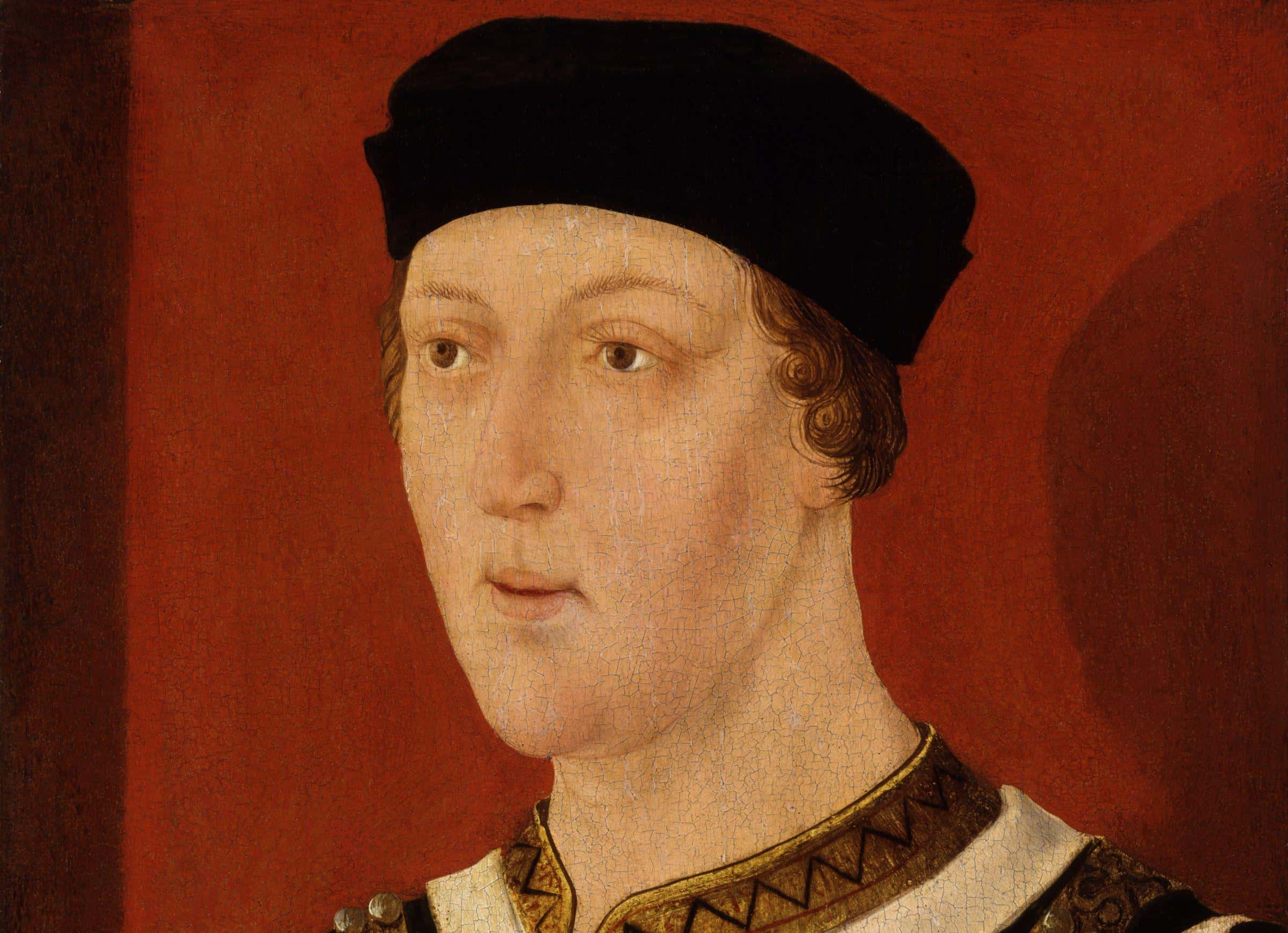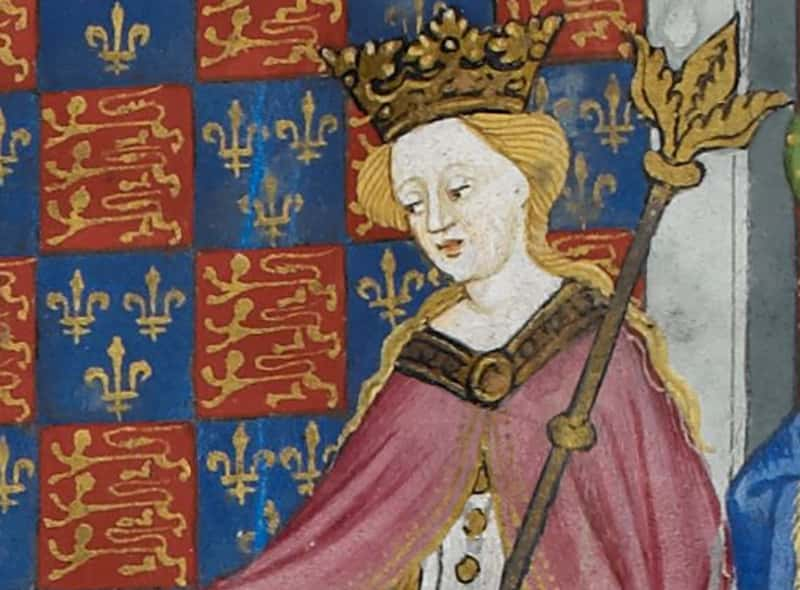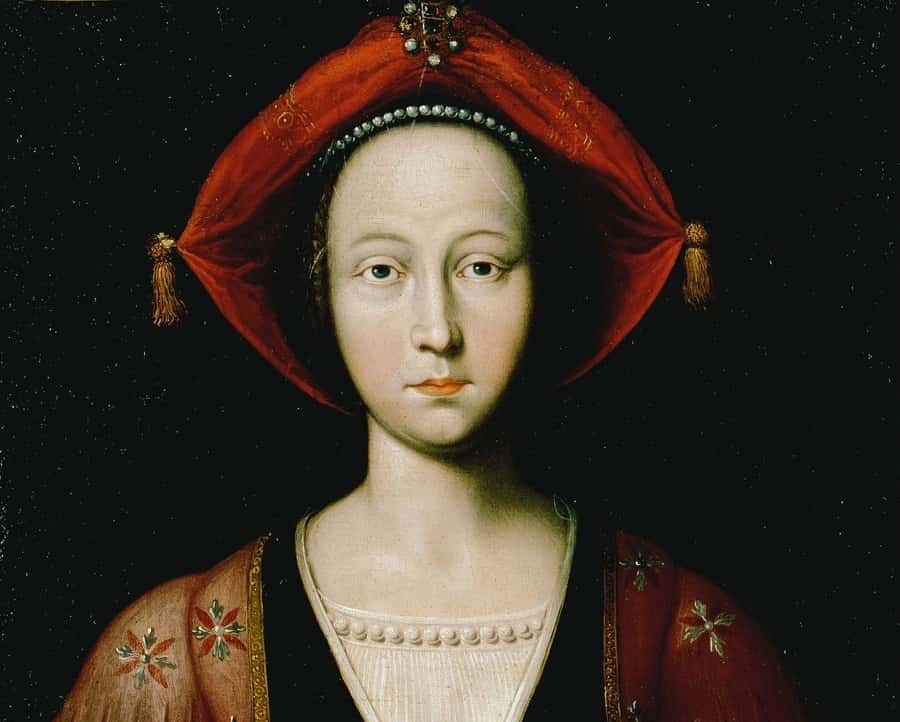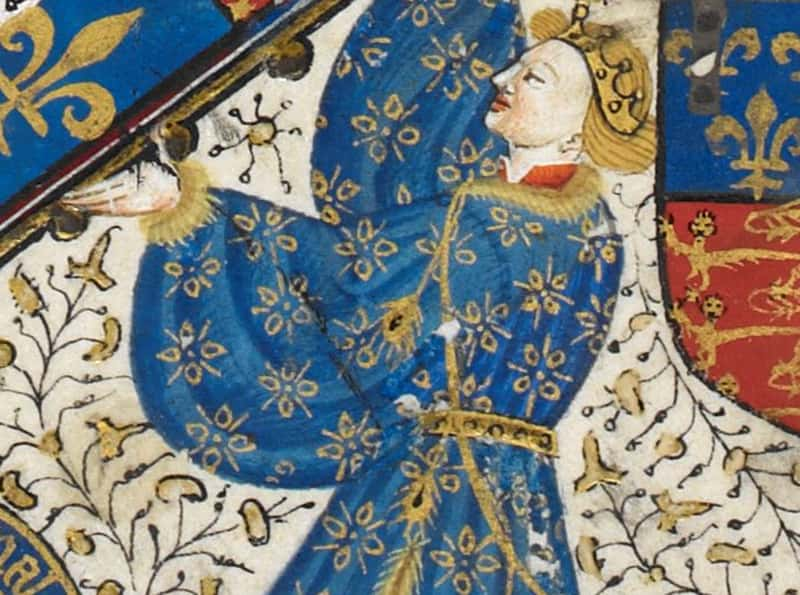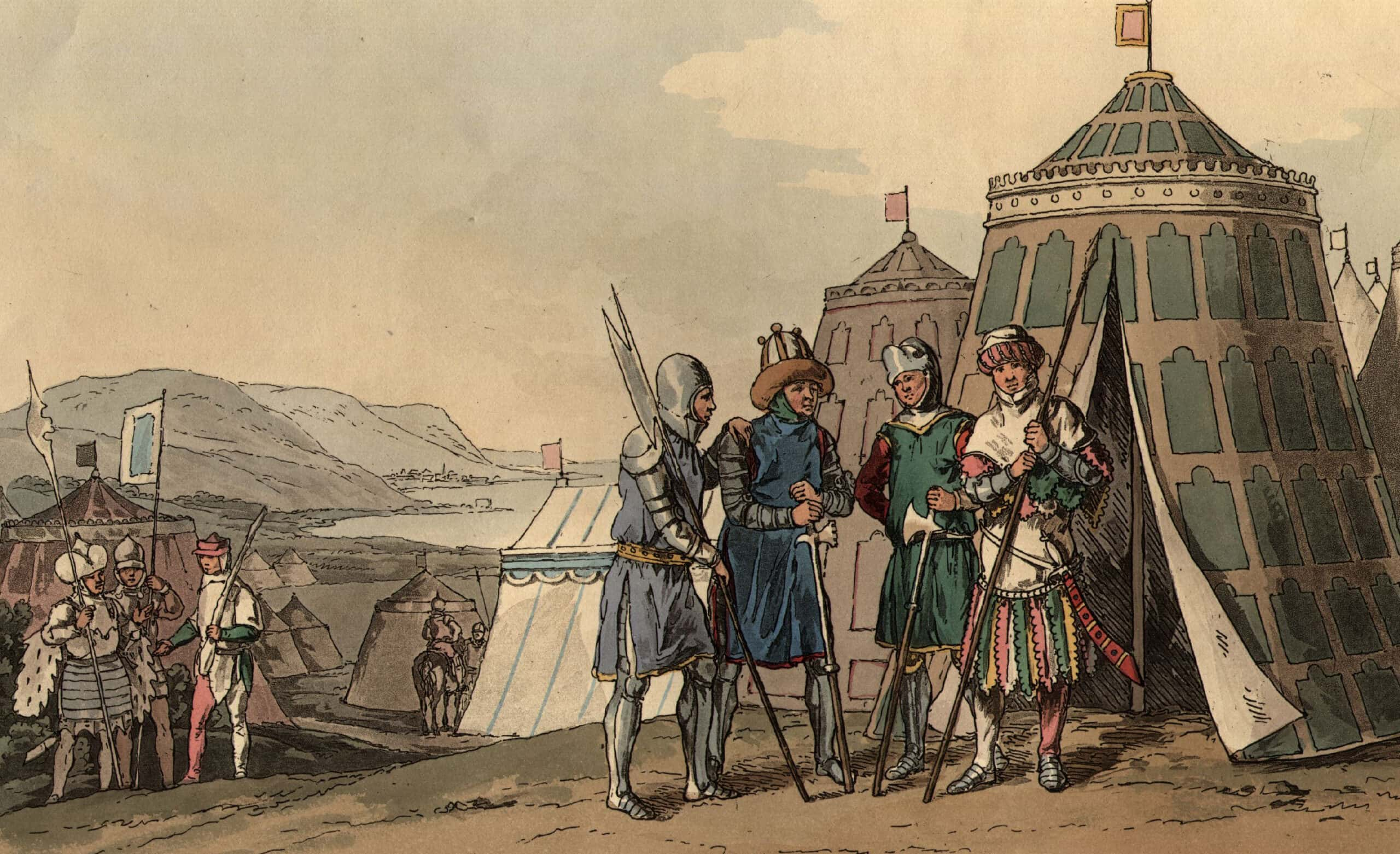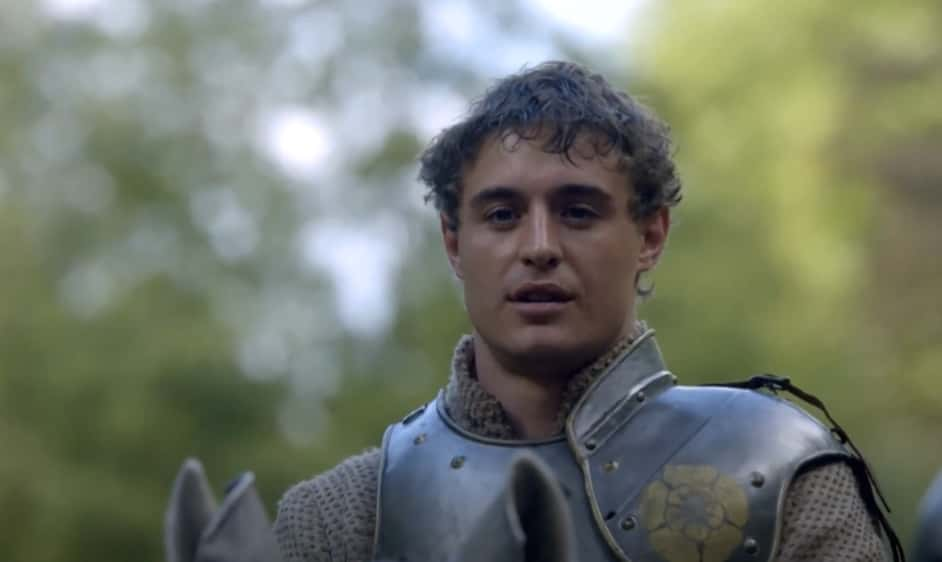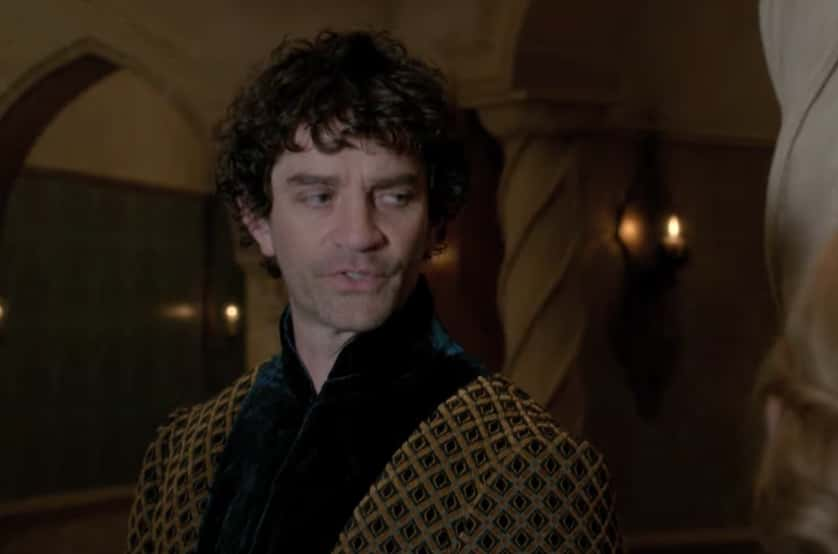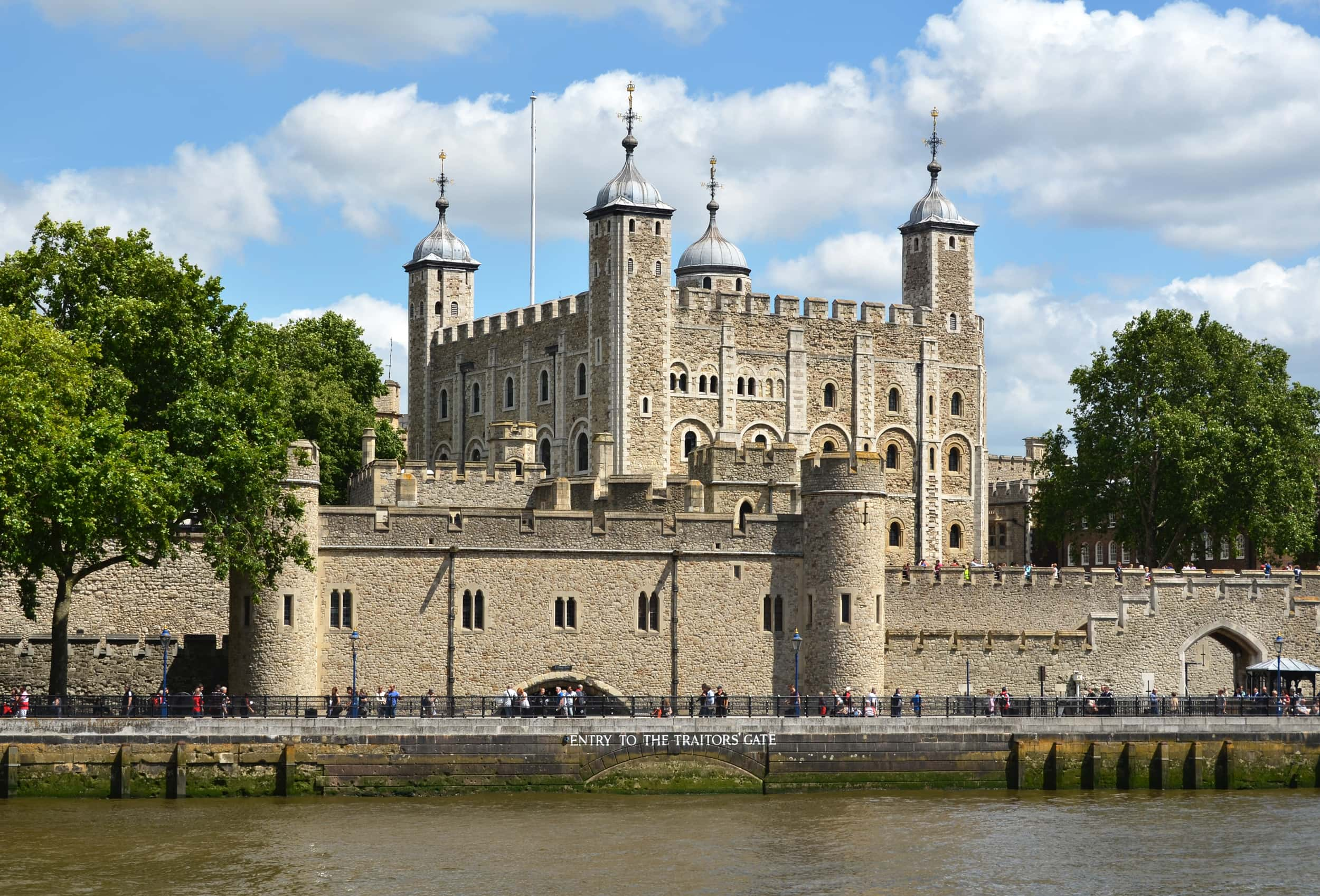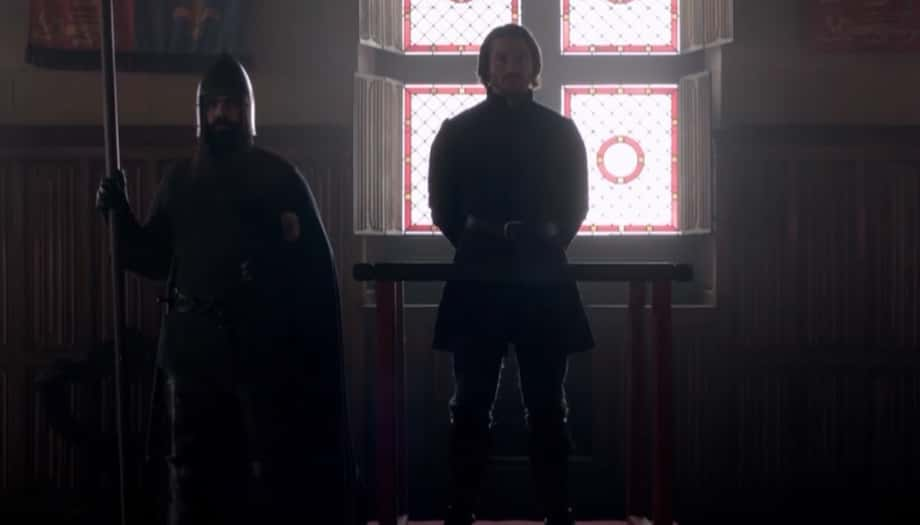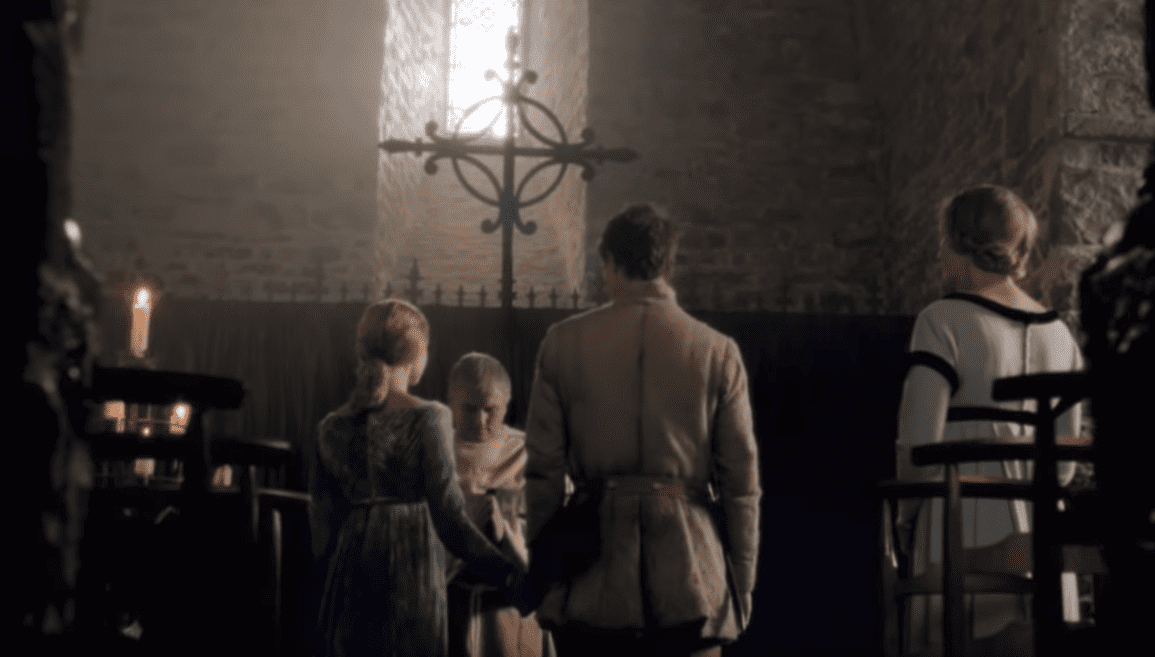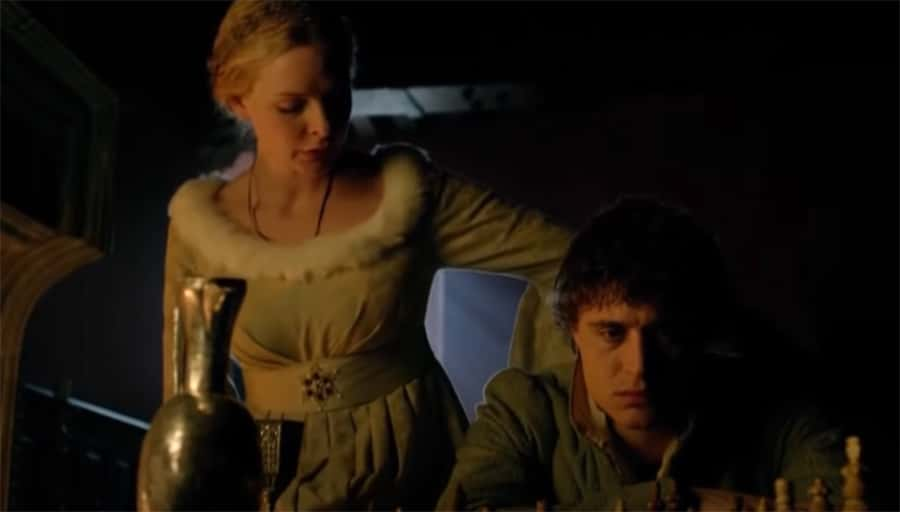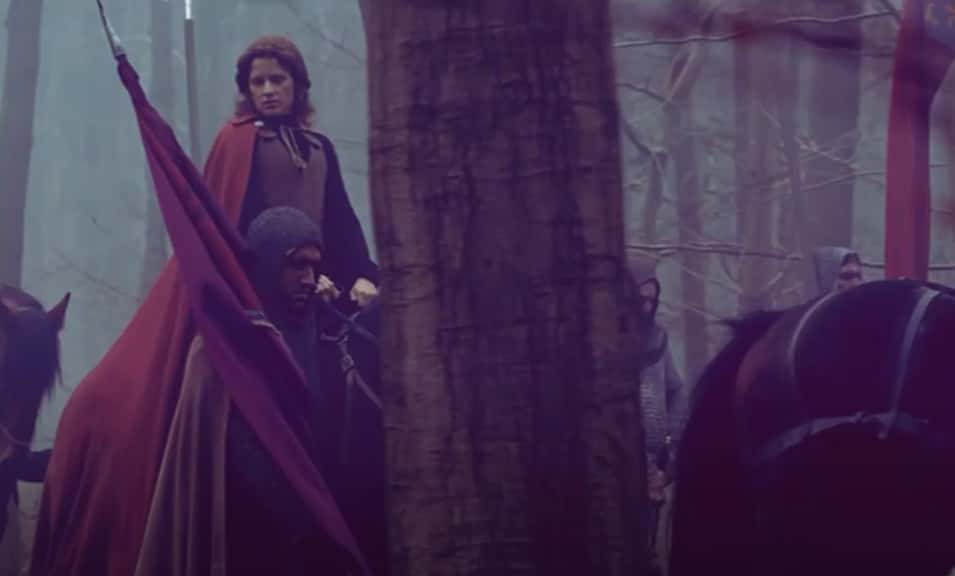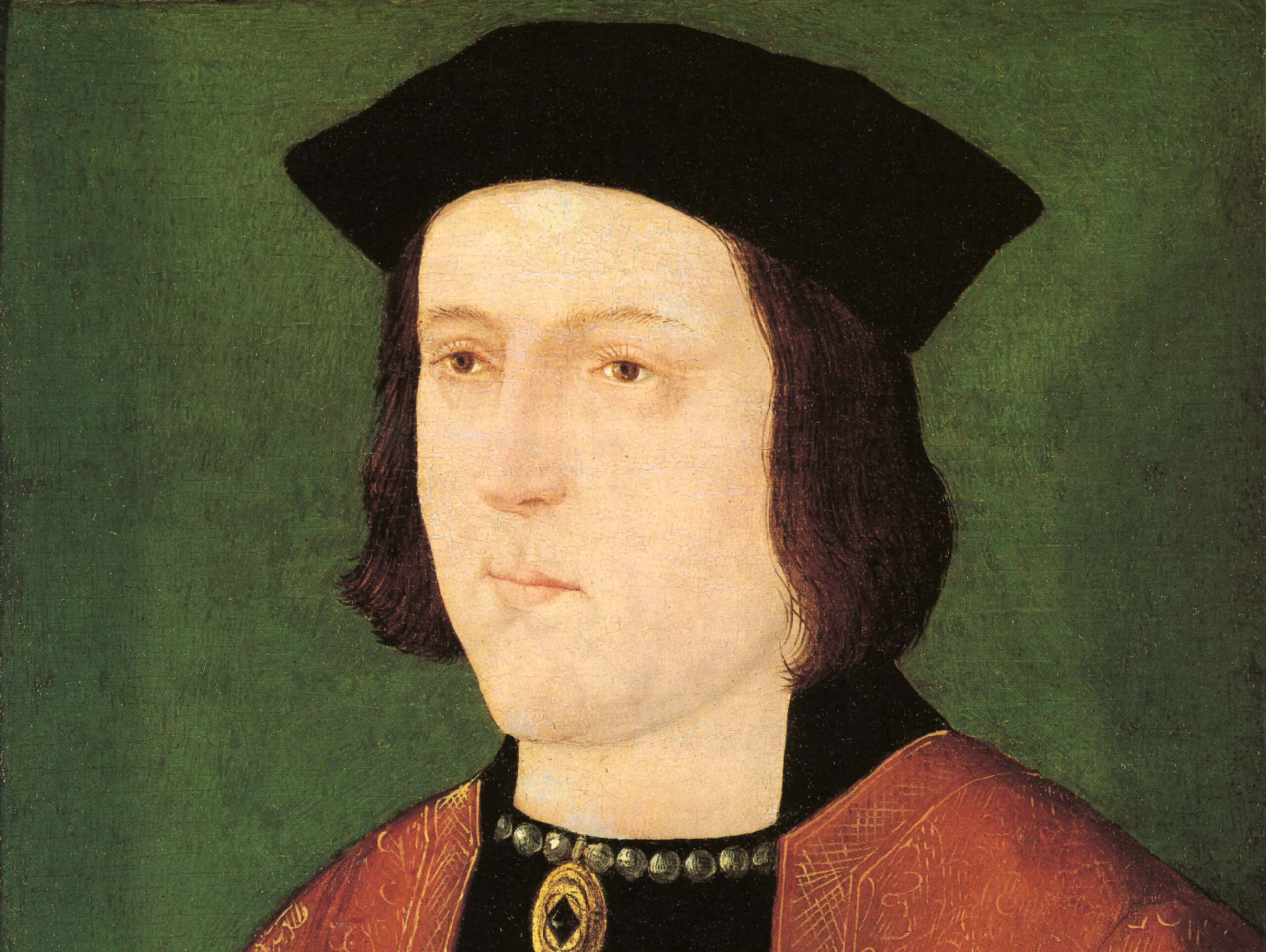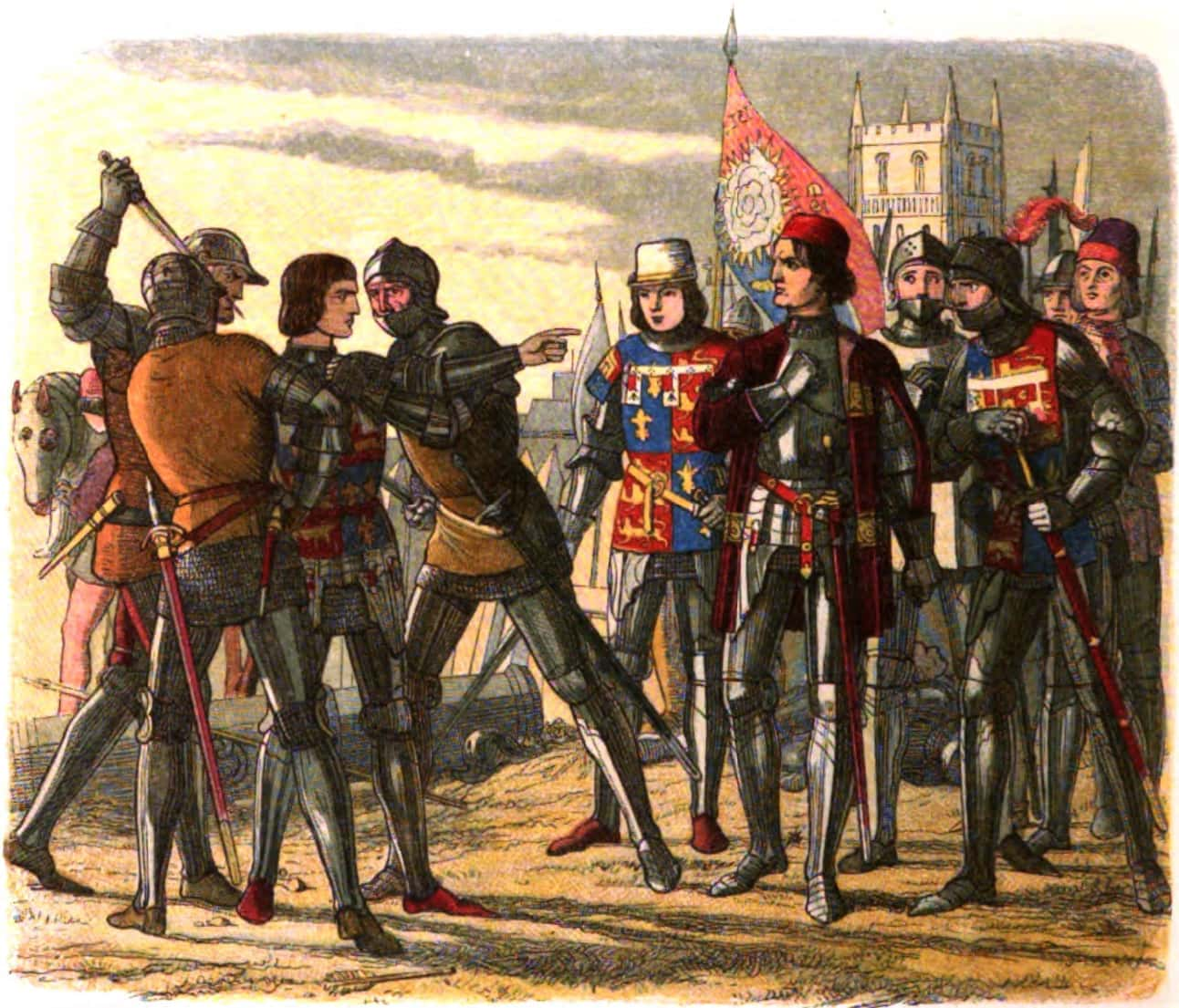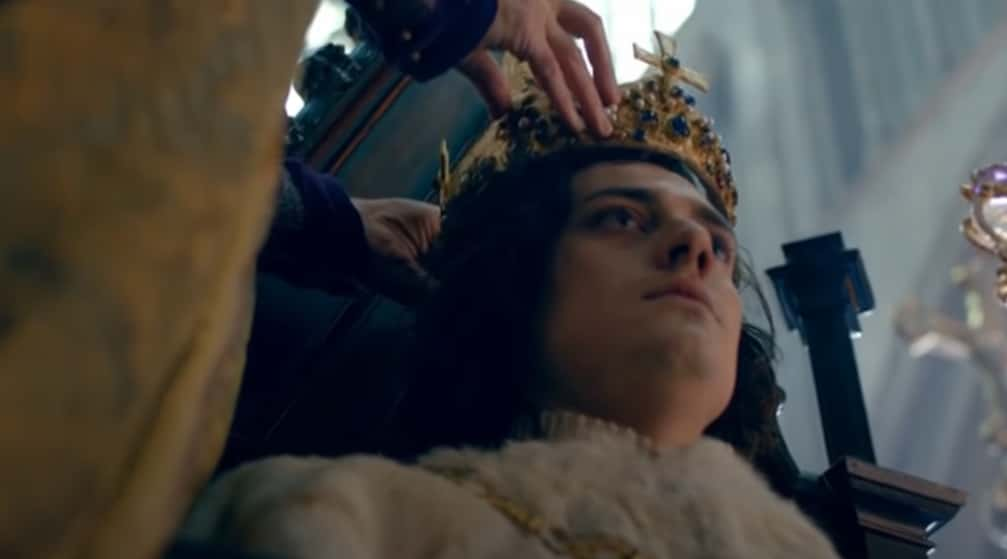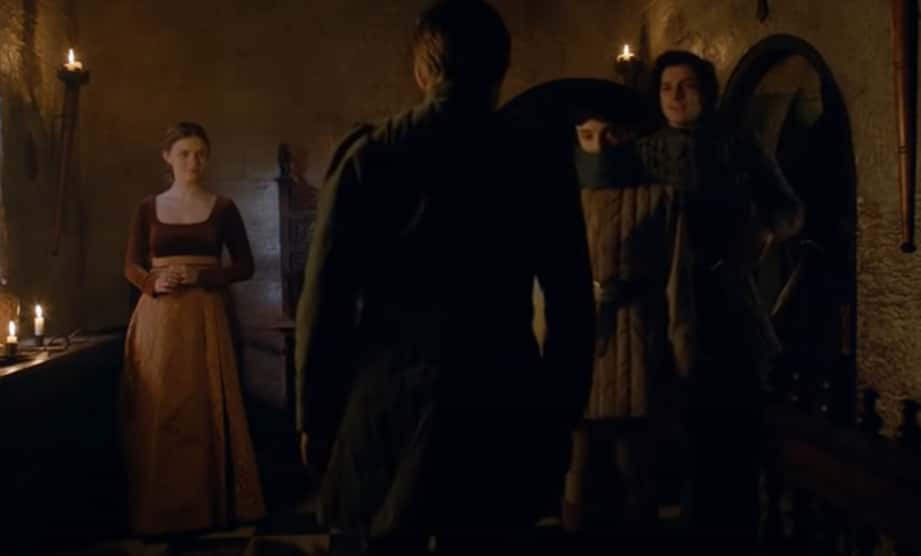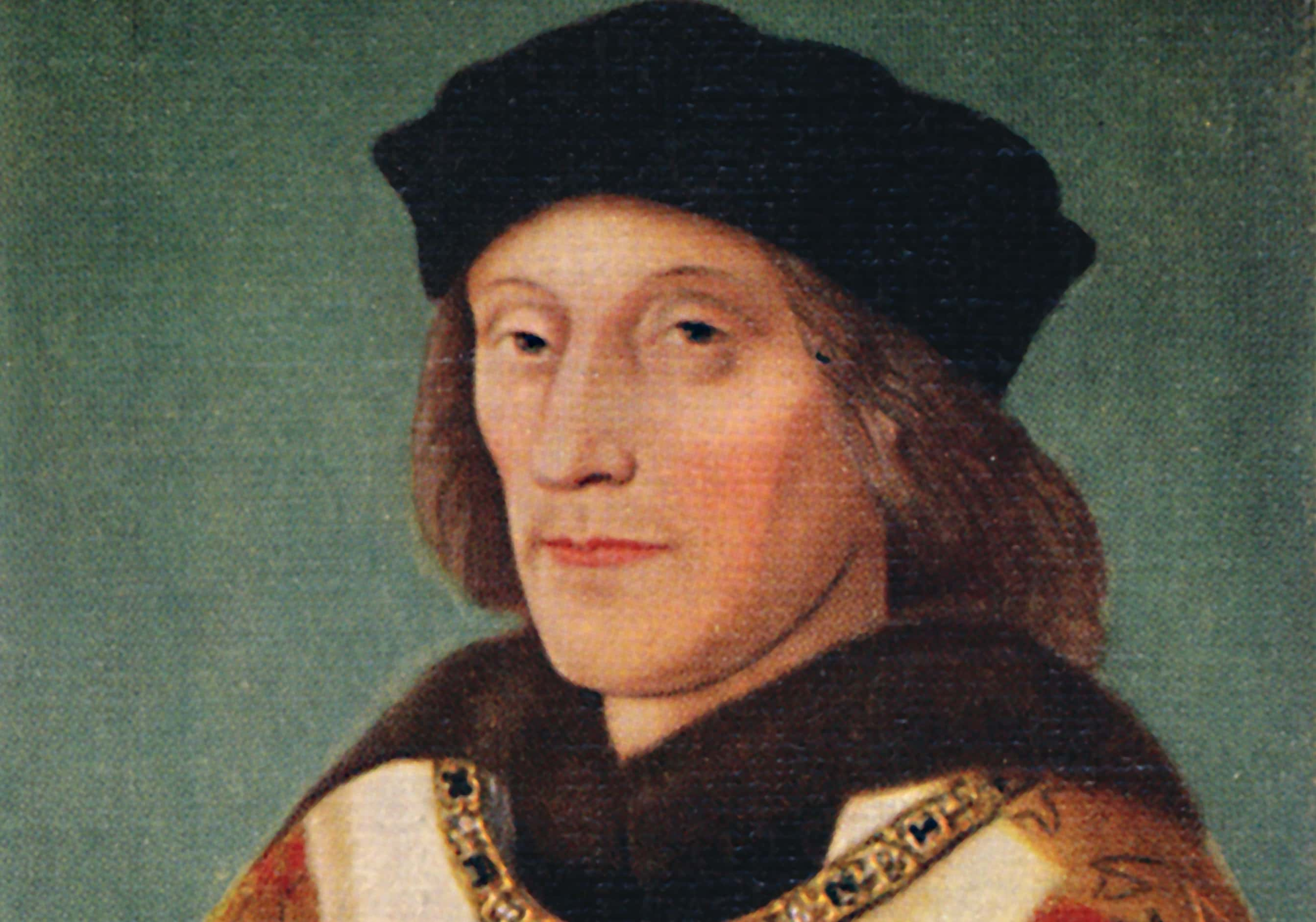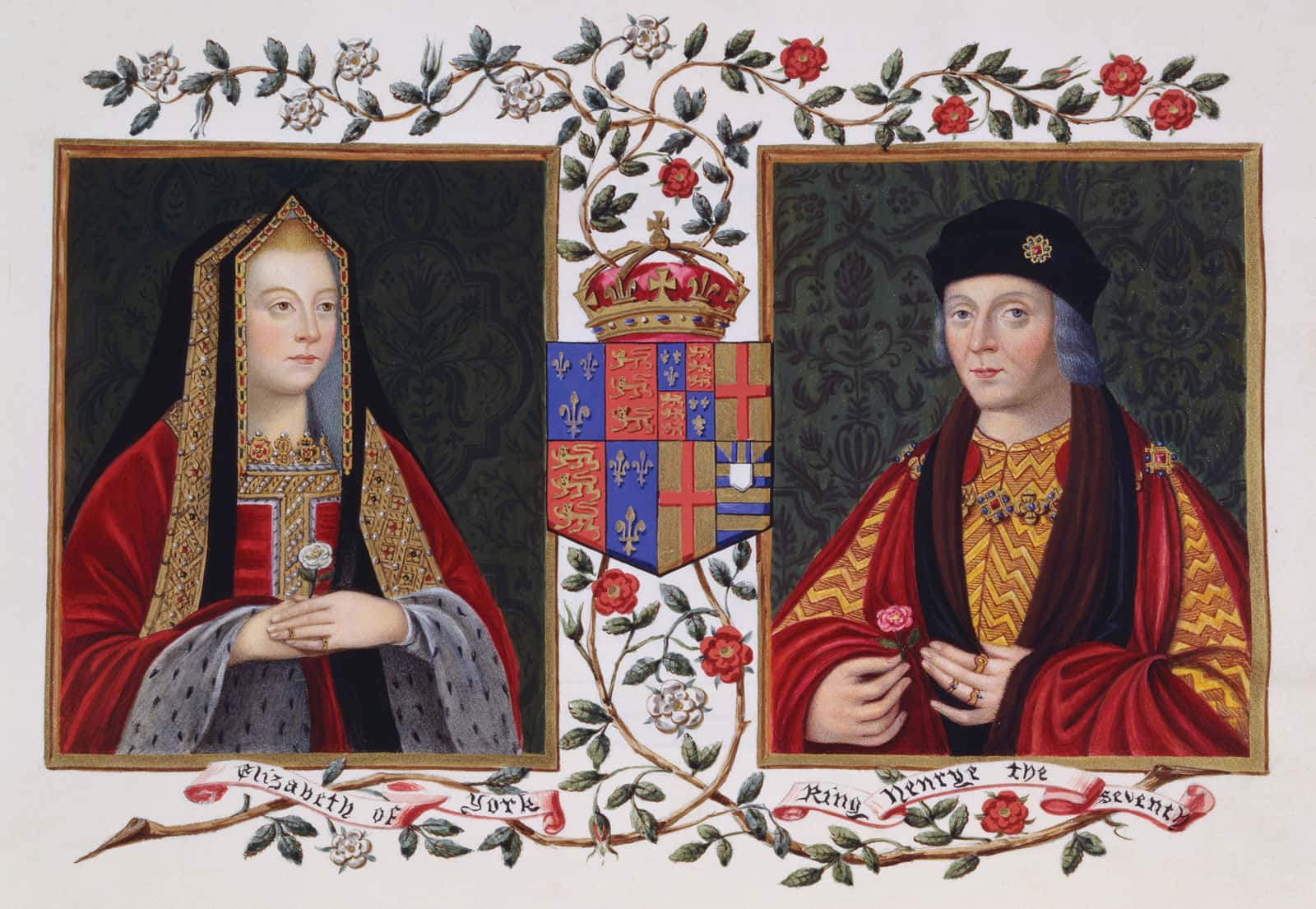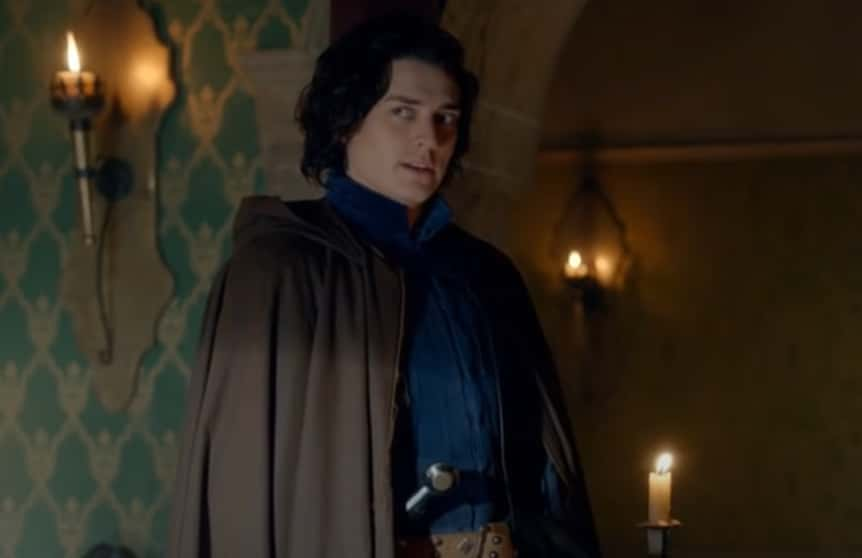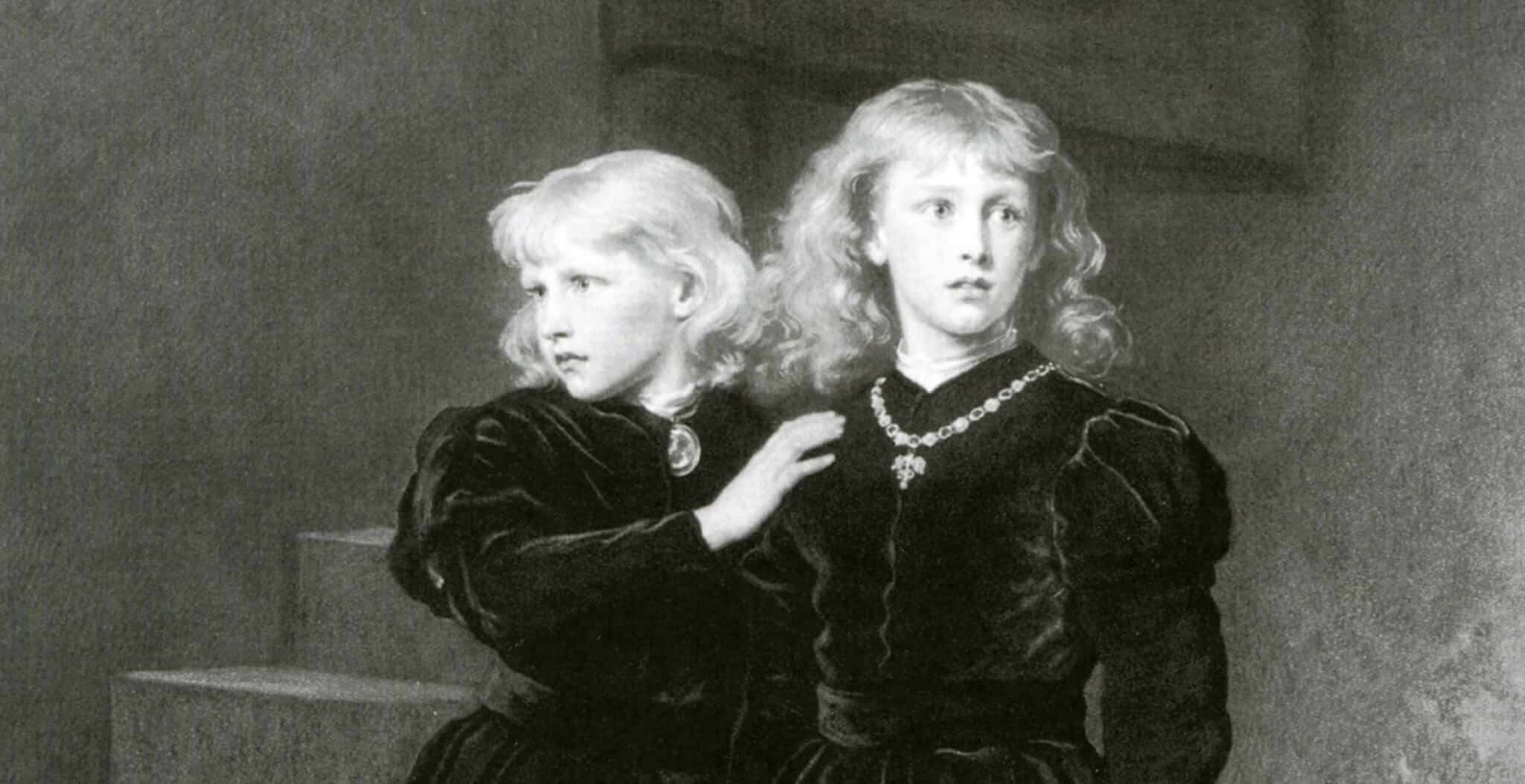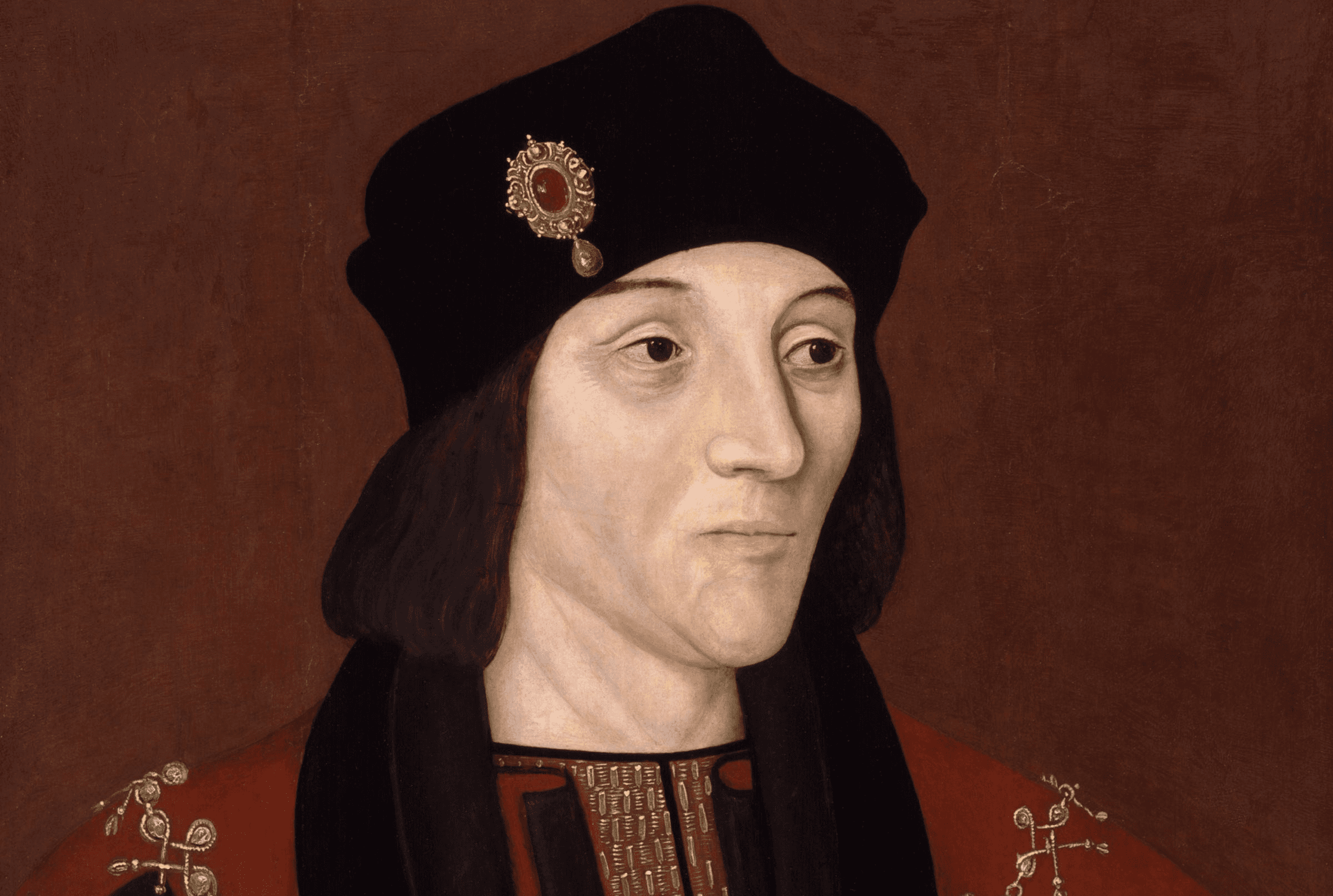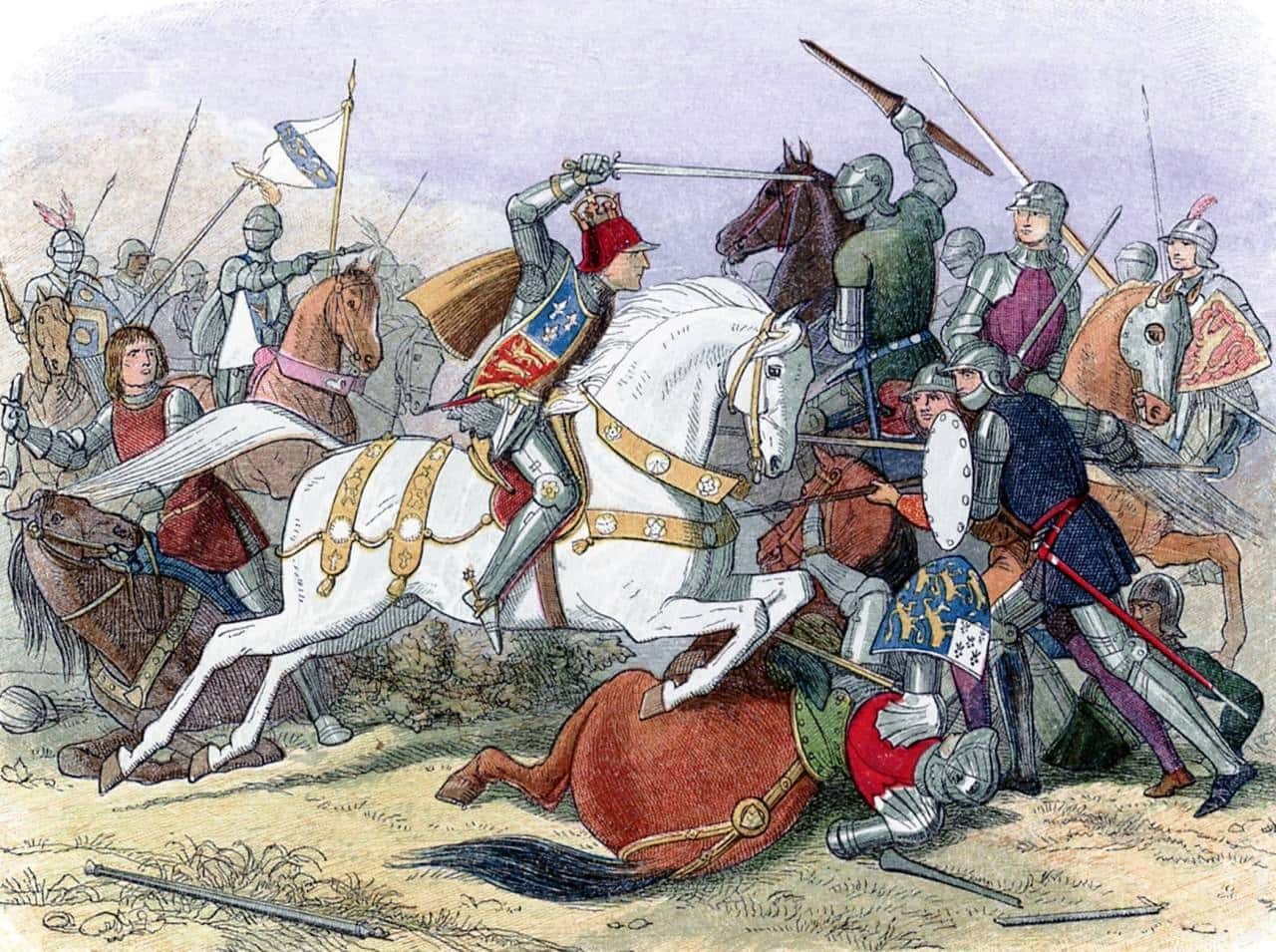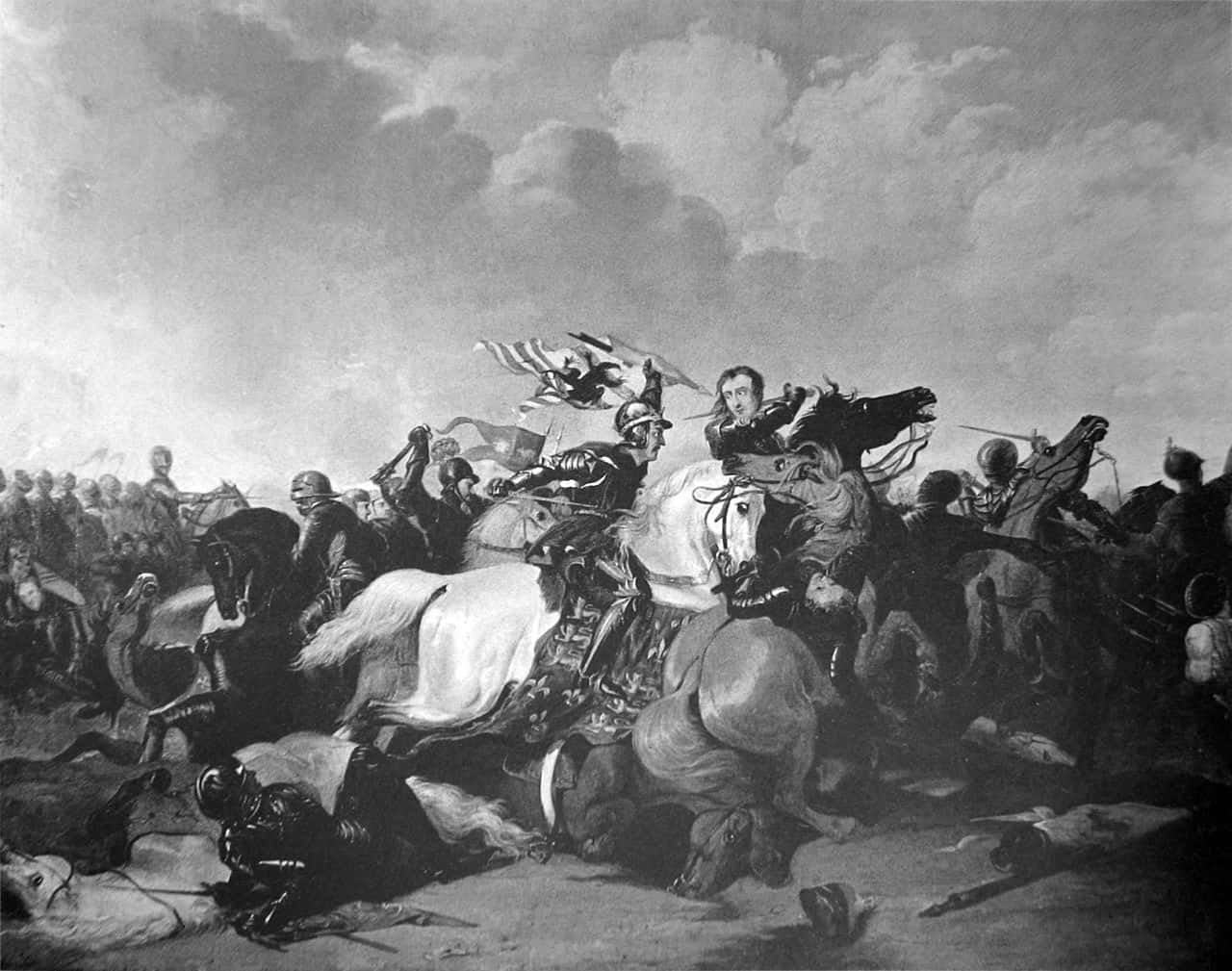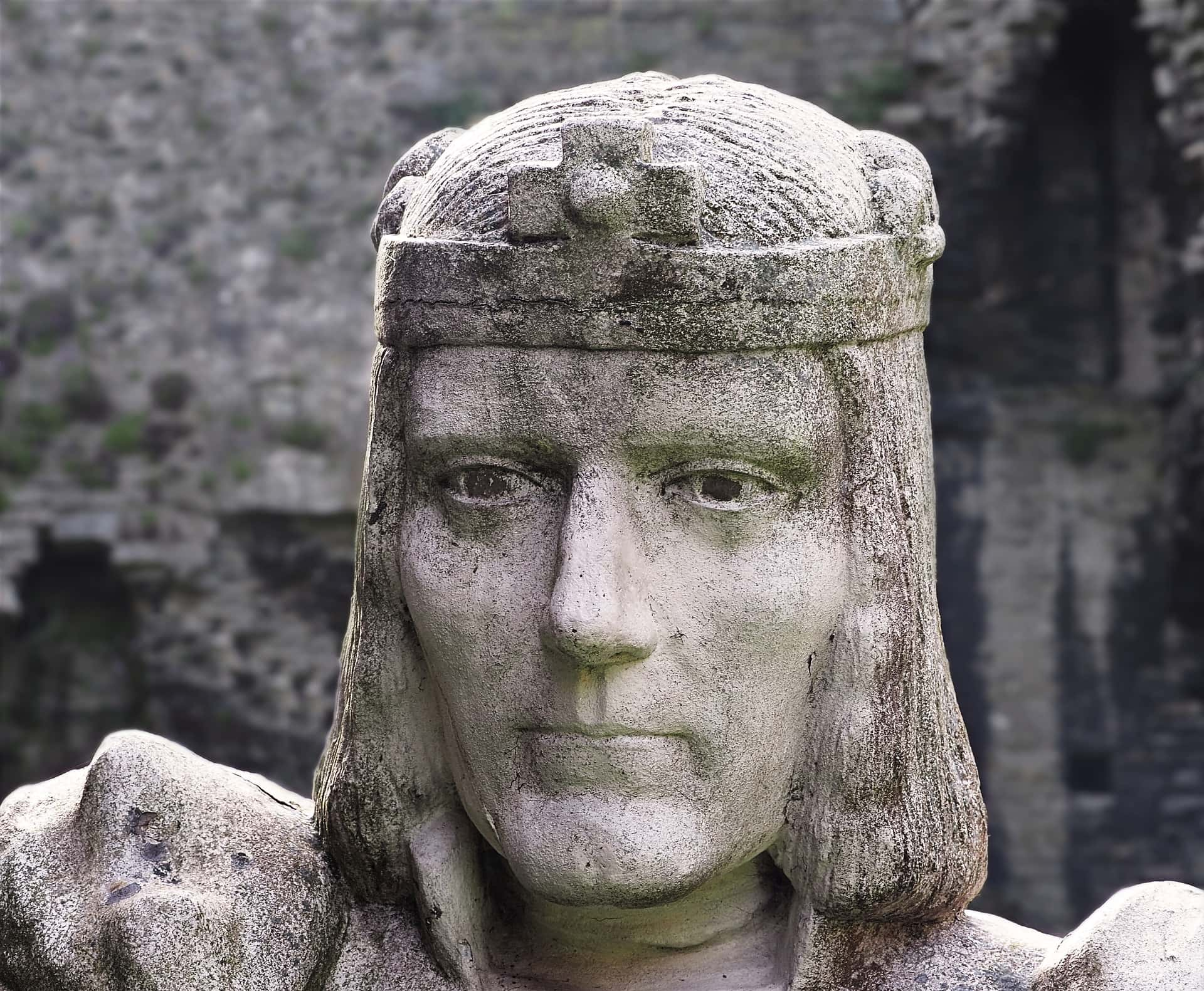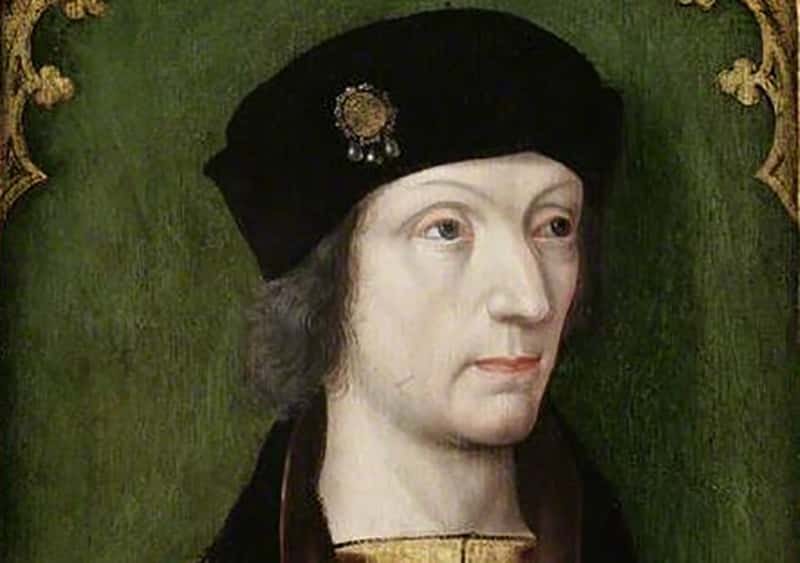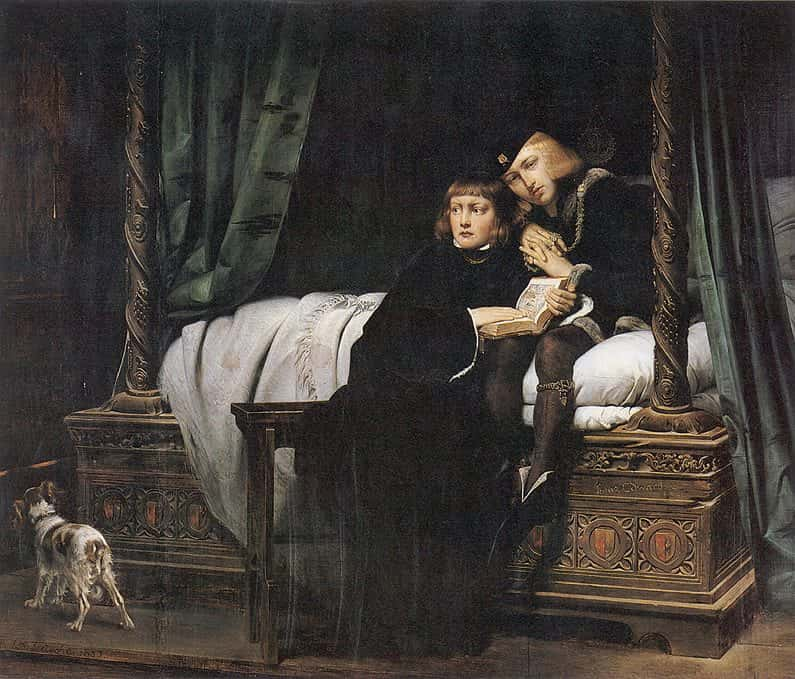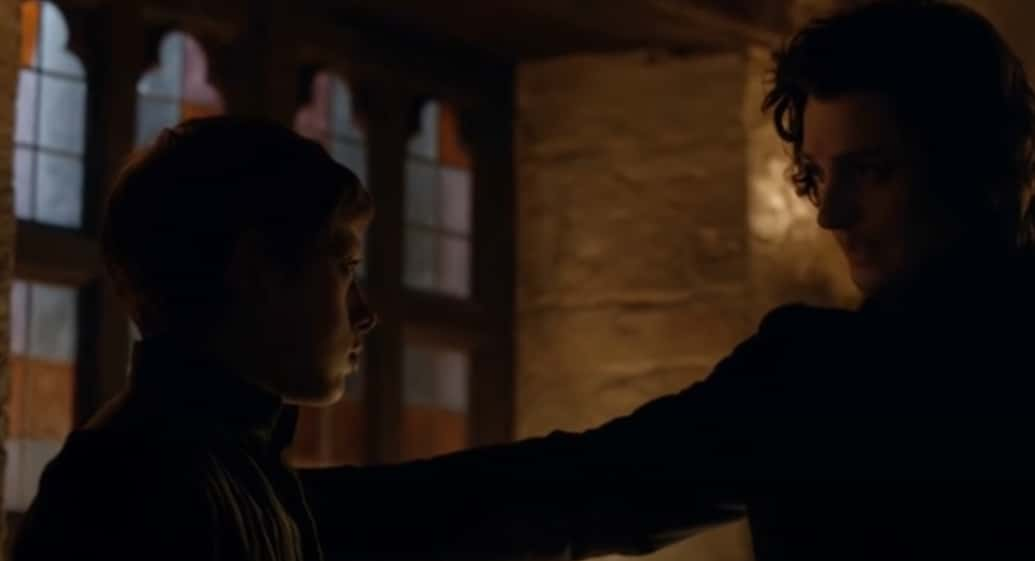Game of Thrones has nothing on the Wars of the Roses. One of the most important conflicts in English History, this brutal saga saw the fall of a mad king, two families torn apart from within, and the rise of one of England's most powerful dynasties. For more than three decades, the White Rose of York and the Red Rose of Lancaster struggled for power on and off the battlefield. But how did it all begin? Who were the winners? Who were the losers? Join us as we delve into the dark history of the Wars of the Roses.
Wars of the Roses Facts
It All Began With the Mad King
To put it as simply as possible, the Wars of the Roses happened because of the Mad King Henry VI. Though his father, Henry V, was one of the most legendary warrior kings in history, Henry VI was famously weak, sensitive, and prone to bouts of insanity. Having such a man on the throne made England's nobles nervous enough, but that wasn't even the worst part.
A Crisis of Succession Didn't Help
Not only was Henry VI a feeble weakling, but even worse, for several years he seemed unable to produce an heir. In cases like these, most people in the Middle Ages would be quick to blame the wife—but in this case, no one dared point the finger at the ruthless Queen Margaret of Anjou. Henry VI might have been scared of his own shadow, but his wife couldn't have been more different...
Margaret Lannister
Many people hated the beautiful Margaret of Anjou, but everyone respected her. She was intelligent, capable, and above all else, ambitious. In fact, when writing A Song of Ice and Fire, Margaret inspired George R.R. Martin to create one of his most cold-blooded characters: Cersei Lannister. The only difference is, Cersei was fictional—while Margaret's dark deeds were all too real.
She Learned From the Best
Margaret took great inspiration from her mother Isabella, the formidable Duchess of Lorraine. When a rival took Margaret's father hostage, Isabella personally led an army to rescue her husband. Afterward, Isabella would continue to take an active role in ruling her husband's domain. It's no surprise that Margaret learned to fight for what was hers.
It Was a Dark Time—No One Was Safe
Henry VI was always unpopular, but the English hated his cronies even more than him. One of the nobles in his clique, the Duke of Suffolk, was so despised that Londoners called regularly for his blood. Instead, the king met the people halfway and settled for Suffolk’s exile. Evidently though, that wasn't good enough for some people...
Suffolk's ship never made it to its destination. As for the duke himself, fishermen found his body washed up on the shores of Dover. This goes to show how little the king’s will was respected by 1450.
Henry Was Mad...And Prudish
Unlike so many other English kings, Henry VI never took a mistress. Maybe Henry loved no one but Margaret, but others have suggested a slightly stranger reason: It was long rumored that Henry had a hopeless phobia of naked bodies. According to one chronicler, King Henry literally ran away in fear after a lord brought a gang of topless ladies to a Christmas celebration as a dirty joke.
 The Hollow Crown (2012– ), BBC
The Hollow Crown (2012– ), BBC
It Began With Love—And Ended In Tragedy
They may have had their fair share of political struggles, but by all accounts, Henry and Margaret had a tender relationship. The couple once kicked off New Year celebrations by receiving their gifts in bed, where they lay in their PJs and pillows all morning and thereby beat John Lennon and Yoko Ono’s celebrity staycation by some centuries.
 The Hollow Crown (2012– ), BBC
The Hollow Crown (2012– ), BBC
Peek-A-Boo
In his more lucid years, a young Henry greeted his bride by disguising himself as a squire and “unmasking” his royal identity to her later in a show of courtly love and pageantry. But this was during the all-too-brief good days. Soon enough, their entire world would be thrown into chaos.
 The Hollow Crown (2012– ), BBC
The Hollow Crown (2012– ), BBC
Too Much To Handle
Despite all of Margaret's efforts to steer England through her husband's madness, things eventually began to fall apart. Perhaps the most humiliating result of Henry’s reign was the loss of England’s territories in France. Most notably, England lost the Duchy of Aquitaine in 1451—a legendary holding that had been in English hands since the days of Henry II.
With the final loss of Bordeaux in 1453, the puny city of Calais was England’s only holding in France. At this point, the Mad King's mind finally snapped...
From the Mad King to the Broken King
Upon learning about the loss of Bordeaux, England’s last important holding in France, Henry VI had a full mental breakdown. He remained unresponsive—basically catatonic—for more than a year. It was a total catastrophe. Having a vegetable king is bad enough, but Henry's collapse couldn't have come at a worse time.
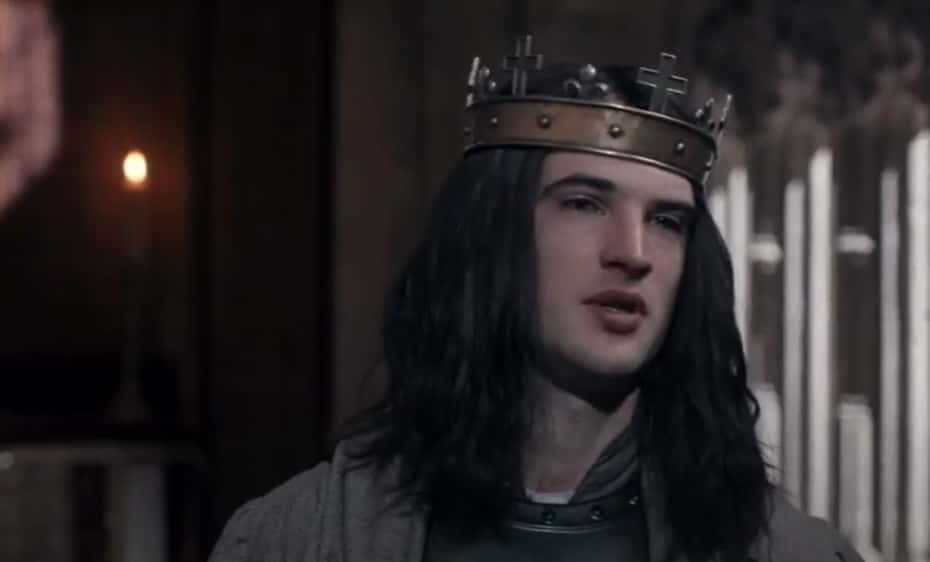 The Hollow Crown (2012– ), BBC
The Hollow Crown (2012– ), BBC
Not Even a Child Could Save Him
During his year-long mental breakdown in late 1453, Henry welcomed his only child, Edward of Westminster. Unfortunately, not even the birth of an heir could snap the king out of his zombie-like state. Perhaps that's for the best, though—because that way, Henry didn't have to hear the dark rumors that swirled around his infant child...
 Wikimedia Commons, John Cassell
Wikimedia Commons, John Cassell
Was Margaret Stepping Out?
For many, it seemed a little convenient that Henry and Margaret's fertility woes were suddenly solved just as the king was at his weakest. Most people around the court believed that the new Prince of Wales was actually the result of an adulterous affair. Now, the only question is, did Margaret have a brother named Jaime?
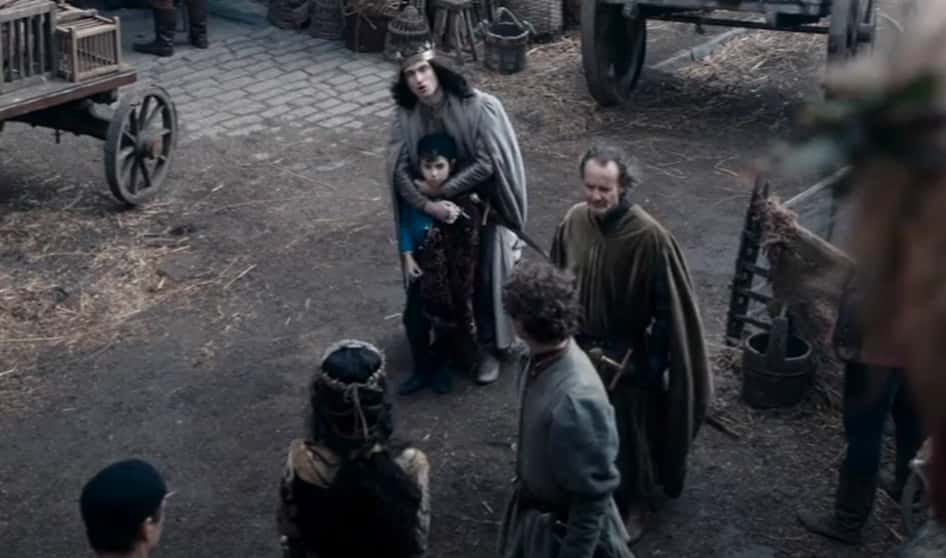 The Hollow Crown (2012– ), BBC
The Hollow Crown (2012– ), BBC
A Gathering Storm
Through the years of shaky leadership under Henry VI, several factions had begun maneuvering for power. By far the most influential was the merciless Richard of York. Richard had had his eyes on the throne for years, and Henry's collapse provided the perfect opportunity. After the Great Council met to determine what to do in the king's "absence," Richard had himself declared England's Lord Protector.
But just as Richard was within grasp of the power he craved so much, something out of his control suddenly threw all of his plans awry...
Waking Up to a Nightmare
Henry finally came out of his mental breakdown around Christmas 1452 and found his world completely upside down. He suddenly had a son...and Lord Protector Richard of York ready to usurp him and claim the crown for himself. Nobles began to back York’s claim to the throne, and he soon began taking control of the government. Thus began what they called “The Cousins War,” though of course, we know it by a different name...
 The Hollow Crown (2012– ), BBC
The Hollow Crown (2012– ), BBC
The Bloodshed Begins
By 1455, political maneuvering had devolved into open warfare. The First Battle of St. Alban's marked the first official fighting of the Wars of the Roses, and it saw Richard of York claim massive victories. First, his greatest political rival, the Duke of Somerset, was cut down in the battle. But more importantly, Richard managed to take a very special prisoner: the king himself.
The Best Laid Plans...
So Richard of York killed his rival and captured the king, that's the end of the story right? The Wars of the Roses were done? Of course not. Even Richard wasn't so bold as to kill the divine King of England in cold blood. Instead, he simply reclaimed the title of Lord Protector, kept Henry under a close watch, and forced the king to name him heir to the throne. That way, he'd have all the power, but wouldn't have to deal with the fallout from killing a king.
Richard had achieved a massive victory—but though he didn't realize it at the time, he was barreling towards certain doom.
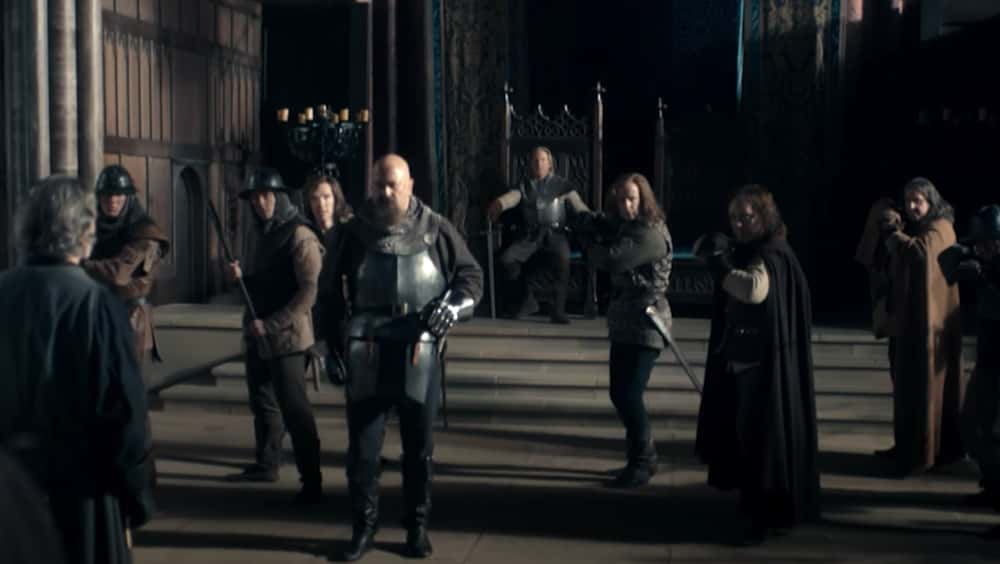 The Hollow Crown (2012– ), BBC
The Hollow Crown (2012– ), BBC
No One Can Say Henry VI Wasn't Creative
In the early days of the Wars of the Roses, Henry VI opted for “Love” over “War.” In fact, he declared March 15, 1458 to be “Love Day.” For real. The celebrations forced the combatants from both sides of the war—Richard's Yorkists and Henry's own Lancastrians—to literally hold hands and walk in pilgrimage with each other to St. Paul’s Cathedral.
Naturally, the handholding didn’t last more than a day; all parties promptly (and I bet rather awkwardly) returned to the business of trying to overthrow their kin the second Love Day ended.
Henry Tried to Inspire Hope—and Paid the Price
Unfortunately, Love Day didn't end the Wars of the Roses. Conflict sprang up once again in 1460, when the Lancastrians and Yorkists met on the field at the Battle of Northampton. Though feeble, Henry himself showed up on the battlefield, with his fierce wife Margaret and young son Edward at his side. He hoped it would inspire his men—but it only ended in utter disaster.
The Captured King
Henry's armies faced the forces of Richard of York and Richard Neville, Earl of Warwick, better known as Warwick the Kingmaker. Warwick was one of the most devious manipulators in all of Europe, and he saw the rise and fall of several kings. At the Battle of Northampton, his and York's armies routed Henry's, and once again, they managed to take the feeble king prisoner.
But while her husband had lost the battle, Margaret of Anjou was not about to let England fall through her fingers that easily...
 The Hollow Crown (2012– ), BBC
The Hollow Crown (2012– ), BBC
Time for Margaret to Fight Back
Up to this point, everything had been going Richard of York's way—but he underestimated his greatest enemy, Margaret of Anjou. While York held her husband captive and made a mockery of the crown, Margaret was out raising an army to fight for what was hers. She finally brought this army against York's at the Battle of Wakefield. By the time the fighting had stopped, the entire nation would be thrown on its head.
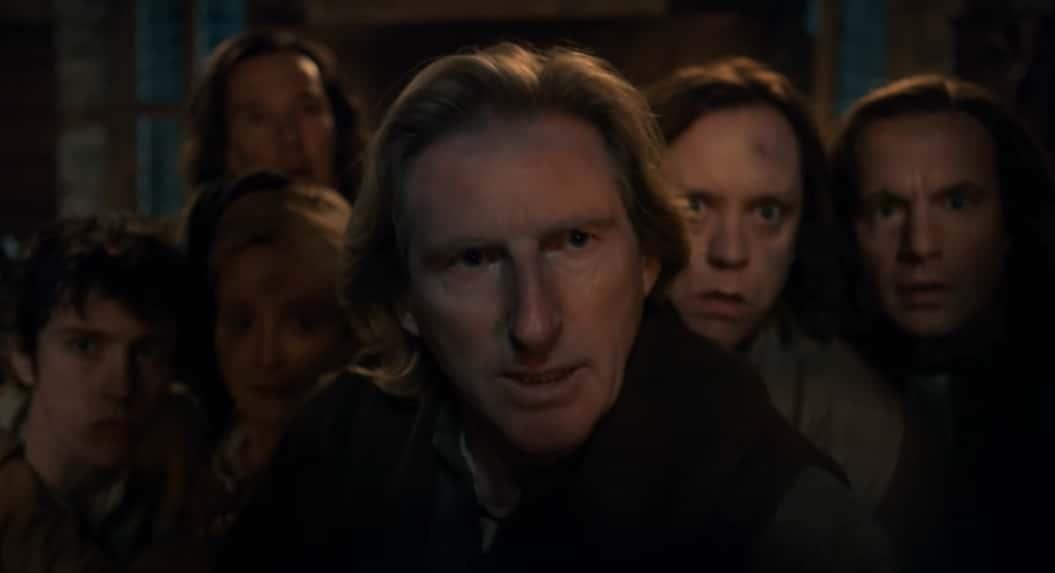 The Hollow Crown (2012– ), BBC
The Hollow Crown (2012– ), BBC
The Pendulum Swings
The Battle of Wakefield could not have been a bigger disaster for the Yorkist cause. Margaret of Anjou's forces completely decimated the York army, but that was nothing compared to the greatest loss of all: Richard of York himself was killed. With the York leader in the ground, it seemed as though the Wars of the Roses had come to a close...but in reality, they were just getting started.
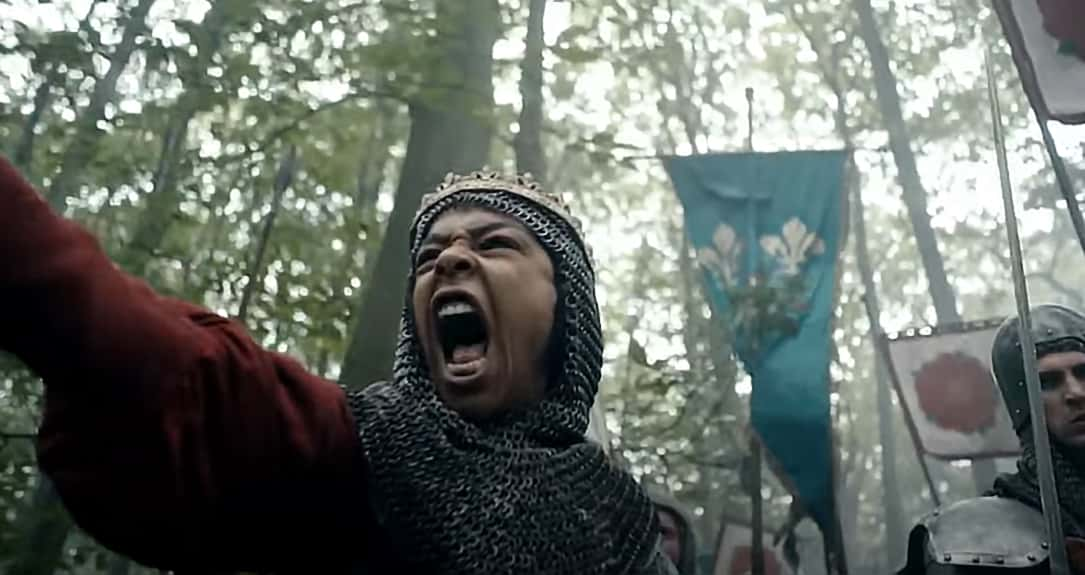 The Hollow Crown (2012– ), BBC
The Hollow Crown (2012– ), BBC
A Paper Crown for a Paper King
In a particularly spiteful gesture, after Richard was killed in battle, the Lancastrians hung up his body over the gates of his hometown of York. As if that wasn't enough, they mockingly placed a paper crown on his head—little did they realize, the real thing would lay upon a York King's head soon enough...
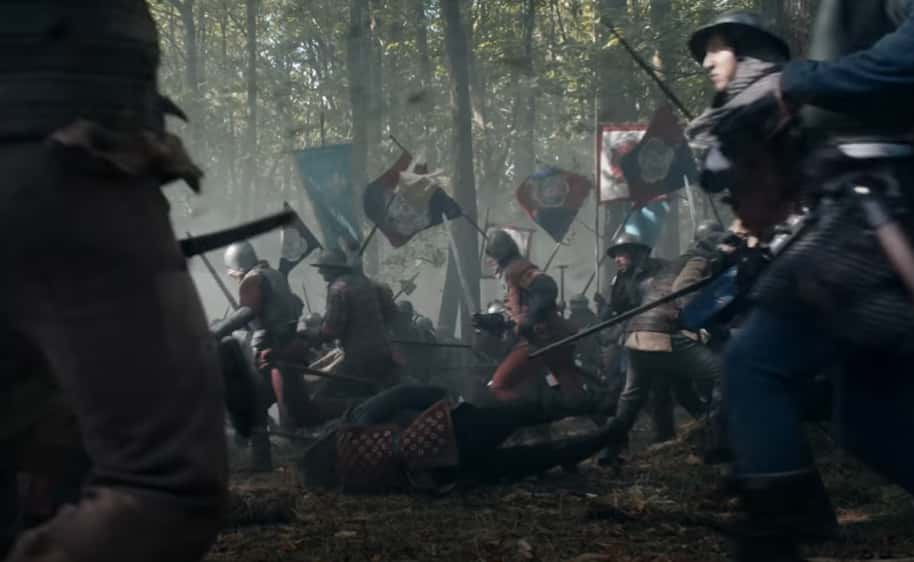 The Hollow Crown (2012– ), BBC
The Hollow Crown (2012– ), BBC
Laughing Through the Chaos
After his wife rescued him from captivity (again), Henry VI fell into yet another bout of madness. As the fighting continued to rage in the background, Henry wandered his palace singing and laughing, completely oblivious to the world around him.
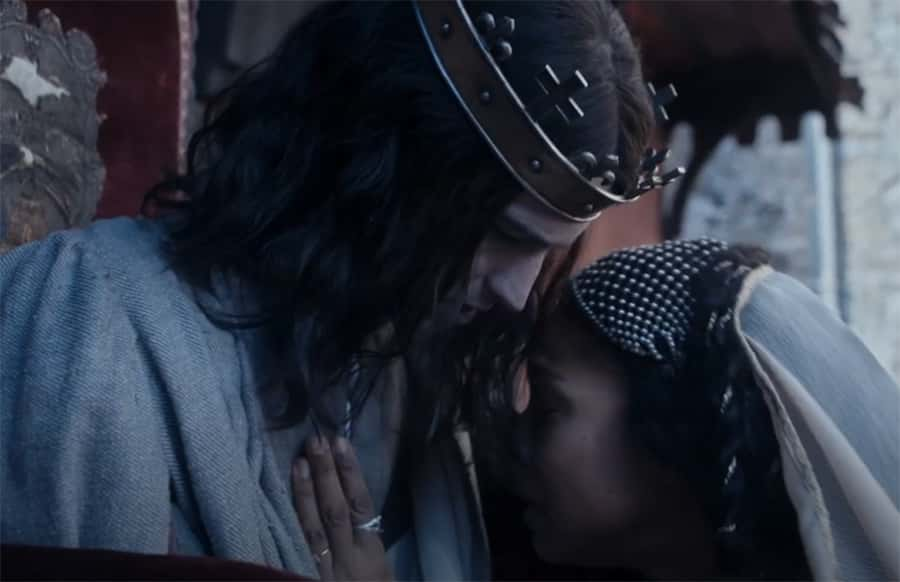 The Hollow Crown (2012– ), BBC
The Hollow Crown (2012– ), BBC
The Wars of the Roses Weren't Over by a Longshot
Though Margaret had defeated Richard, the Yorkists weren't about to roll over and concede defeat. Even with their figurehead gone, that didn't change the fact that the Mad King had to go. Fortunately for them, Richard had a son, who was everything Henry VI wasn't. Edward of York was a giant of a man, and when he strode out onto the battlefield resplendent in the finest armor, the weak Henry looked even worse by comparison.
A New King...But for How Long?
Reinvigorated under Edward's leadership, the Yorkists went back on the warpath. Mere months after their devastating defeat at Wakefield, Edward met the Lancastrians once more on the field of battle. During a raging March snowstorm, the two armies faced off at the Battle of Towton, and this time, York landed on top. In one of the bloodiest battles in the history of England to that point, Edward's forces completely decimated their rivals.
After the brutal victory, Edward finally did what his father never had the guts to do: He had Henry deposed and crowned himself King Edward IV. York had finally come out on top—but the Wars of the Roses were far from over.
Uneasy Lies the Head That Wears the Crown
With the help of Warwick the Kingmaker, Edward IV had claimed victory for the House of York. He threw the now-disgraced Henry VI in the Tower of London and set about the business of being king. But before the dust had even settled, Edward made a fatal mistake: he crossed the Kingmaker, and he would soon suffer the consequences.
The Poet King
The king formerly known as Henry VI seemed to be having a pretty nice time as a prisoner in the Tower of London. After all, he'd never done very well as king, and suddenly, he had the time to pursue more artistic pursuits. Henry passed much of his time in captivity composing poetry.
Edward Could be Merciful—But He had His Limits
Edward was a gregarious king and that was reflected in the second chances he gave his enemies. After his younger brother George and the Earl of Warwick rebelled against him in 1469, Edward would have been completely justified in exiling or outright executing them. Instead, Edward embraced them in forgiveness. At least, he did this time…
Time To Die, Brother
No one was safe from Edward IV's wrath—not even his own family. After plotting against him yet again, Edward's brother George was captured and convicted of treason. Edward had his brother executed in private, and if the rumors are true, he made sure it was brutal. Legend has it that Edward had George drowned in a butt of Malmsey wine. Even in peacetime, the Wars of the Roses had their fair share of death and drama.
A Shocking Betrayal
Remember how Robb Stark sealed his fate by betraying his allies and marrying for love? Where do you think George R.R. Martin got that idea? Not long after Edward IV became king, his ally, the Earl of Warwick, began planning a political marriage to strengthen the Yorks' hold on the throne. Little did he know, while he was out playing the game of thrones, Edward secretly married the beautiful, yet low-born, Elizabeth Woodville.
By all accounts, Edward and Elizabeth married for love. Edward knew that their union would anger many, most-importantly the Kingmaker, but went through with it anyway. Yet still, he couldn't have imagined the fallout that was coming.
It was Love at First Sight
According to legend, Elizabeth Woodville caught King Edward’s eye on the side of the road, of all places. Woodville stood under an oak tree with her sons, putting herself directly in Edward’s path to petition for the restored land of her late husband. Edward’s was struck by Woodville’s legendary beauty and begged that she be his mistress. Little did he know, this gesture would start the Wars of the Roses right up again.
For a King, Love has Its Limits
Despite his love match with Elizabeth Woodville, Edward was fairly open about his adultery. He once proudly (and publicly) declared his enjoyment of three mistresses, whom he successively called "the merriest, the wiliest, and the holiest harlots" of England. Classy, Edward, real classy.
He Thought He Could do Anything...He was Wrong
Edward's secret marriage was infuriating enough, but he wasn't done stabbing his allies in the back. He completely ignored many of the people who had helped him win the throne, and instead gave out most of the country's important positions to his new wife's family. Even worse, Elizabeth's kin had fought against the Yorkists in the Wars of the Roses.
Edward felt like he could do whatever he wanted—he was king, after all—but he was about to learn that even kings have to pay the piper.
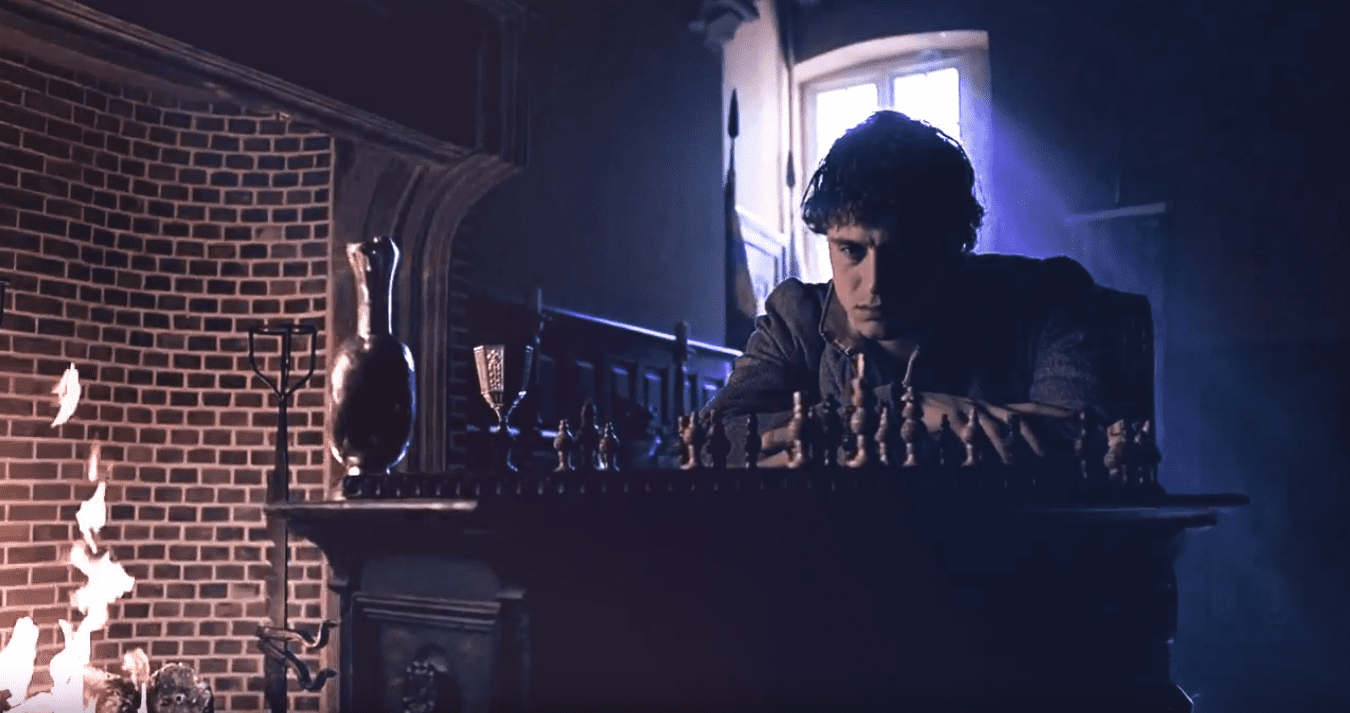 The White Queen, BBC Drama Productions
The White Queen, BBC Drama Productions
The Ultimate Betrayal
Richard Neville, the Earl of Warwick, had given his own blood, sweat, and tears to see Edward on the throne. Now, the new king had cast him aside like he was nothing. The Kingmaker was not about to take that sitting down. First, he tried to convince Parliament to name Edward's brother George the king instead. When they refused, Warwick hatched another plan—but this one required doing the unthinkable...
Mortal Enemies Become Uneasy Allies
When everything else had failed, Warwick turned to his greatest enemy for help: Margaret of Anjou. He'd spent years doing everything in his power to have her husband dethroned, but when the fighting was over, Warwick found he'd created a monster. He wasn't about to let anyone, even the man he made king, push him to the sidelines, so Warwick sailed to France to join forces with the exiled Queen.
Apparently, in the Wars of the Roses, anything was possible.
The Power Move to End All Power Moves
Queen Margaret of Anjou was the Earl of Warwick's last chance—but she was not about to forget their years of conflict so easily. When Warwick showed up at her doorstep, looking for an alliance, she made one of the greatest power moves in history. She forced her one-time foe to kneel in front of her in complete silence...for 15 minutes. But if anything, seeing his own king turn on him had humbled Warwick. He did as she asked, and they soon began plotting to free Henry VI and put him back on the throne.
Henry VI may have been mad, but at least he could be controlled. Edward IV was a different beast entirely.
It Can All Fall Apart in an Instant
After ruling for the better part of a decade, Edward IV suddenly found himself facing the united front of his worst enemy and his biggest ally. To make matters even worse, his rule had been deeply unpopular thus far. So, when the Lancastrians arrived on English shores with an army of 30,000, Edward was forced to realize the grim truth: either he stayed to be killed in battle, or he fled to exile to fight another day.
Edward chose the latter. He ran away to Belgium, while Margaret and Warwick freed the Mad King and put him back on the throne. The crown had swung back to the House of Lancaster—but if Margaret thought that Edward was finished, she was dead wrong.
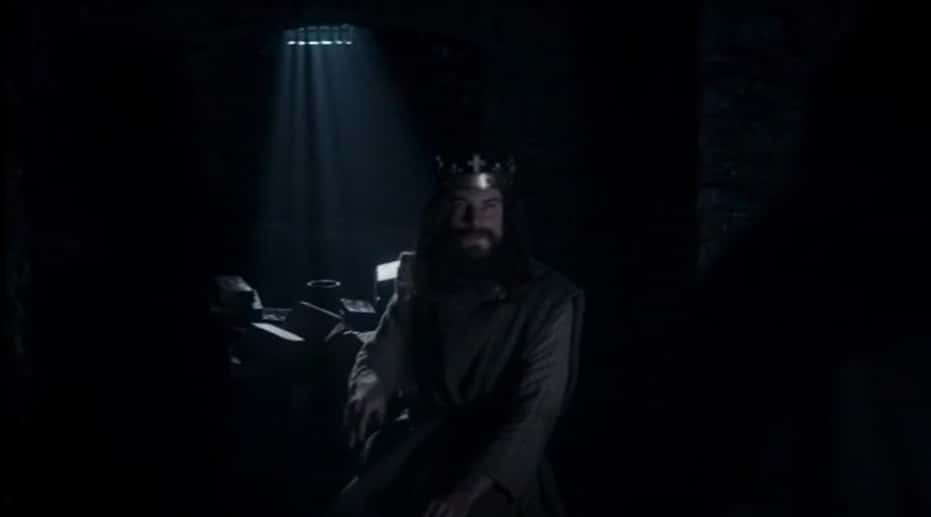 The Hollow Crown (2012– ), BBC
The Hollow Crown (2012– ), BBC
A House of Cards
Margaret of Anjou and the Earl of Warwick's alliance quickly deposed Edward and restored Henry VI to the throne, but this tenuous balance of power was doomed from the start. First, the fact remained that Henry VI was completely unstable and utterly useless as a king. Furthermore, the Lancastrians were not about to forget that Warwick had spent years battling against them. Many nobles had lost fathers and sons fighting against Warwick and the Yorkists.
England was a ticking time bomb, and it was only a matter of time before it exploded...
Edward's Back, and He Means Business
Just a year after he fled with his tail between his legs, Edward IV returned to English shores, intent on taking back his throne. He found a nation in complete upheaval and was quick to take advantage. It didn't take much convincing to gather men to his cause, and soon, he had an army. Meanwhile, the Lancastrians were in complete disarray. So much so that Edward was able to stroll into London completely unopposed, taking the Mad King prisoner once again.
Edward had lost his throne was, and he was going to make sure he didn't lose it again—no matter the cost.
The End...?
Soon after Edward's return to England, two brutal battles saw the final nails hammered into the Lancastrian coffin. First, at the Battle of Barnet, Edward's one-time ally, the Earl of Warwick, was killed. Then at the Battle of Tewkesbury a month later, Henry VI's young son, Edward of Westminster, died as well. With the king his prisoner, the heir to the throne dead, and the Kingmaker gone for good, there was finally nothing standing between Edward and the throne.
No Safe Haven From Edward's Wrath
Edward was absolutely merciless when it came to his enemies. After the Battle of Tewkesbury, he famously yanked Lancastrian survivors out of religious sanctuary and brutally executed them, despite the fact that churches were supposed to be safe havens for all who sought asylum in them. After losing his crown once, Edward was not messing around this time.
The King is Dead, Long Live the King
Shortly after Tewkesbury, the Mad King Henry VI finally died, still locked up in the Tower of London. His death, and the second coronation of Edward IV, meant that England finally saw some semblance of peace. For the next 12 years, Edward reigned and life returned back to normal. It seemed like the Wars of the Roses were going to become nothing more than a distant memory—but soon, a shocking tragedy would change everything and throw England back into chaos.
The Peace is Broken
After spending his life on the battlefield, King Edward VI suffered a remarkably mundane death. Around Easter, 1483, after over 12 years of relative peace, Edward simply fell ill and died. Now, this shouldn't have caused that much of a stir. After all, Edward had two living sons, and his eldest was quickly proclaimed king. But there was one problem: no one had accounted for Edward's ruthless brother Richard.
Richard had spent his entire life in someone's shadow. First, it was his father, Richard of York, and next it was his brother Edward. Finally, an opportunity arose for Richard to take power for himself—and he was willing to go to disturbing lengths to do it.
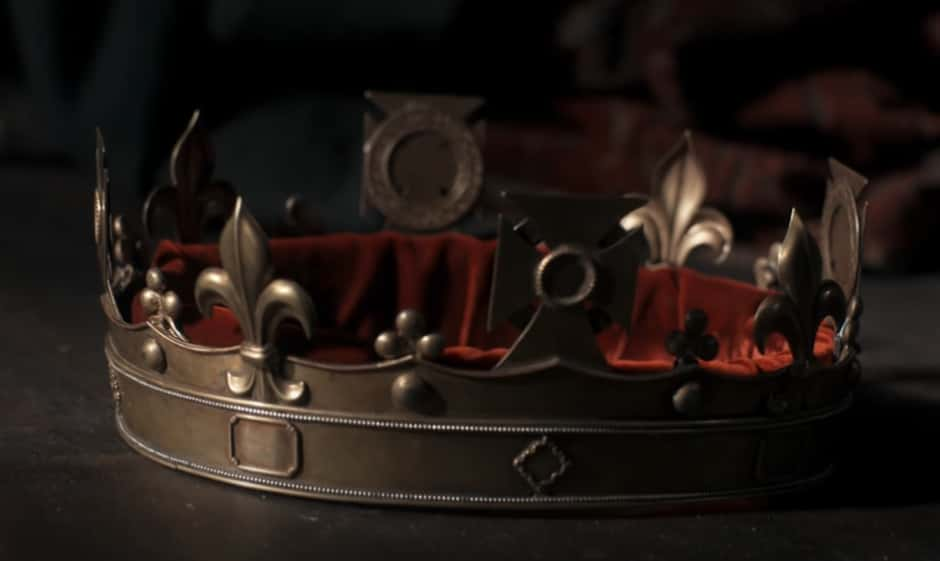 The Hollow Crown (2012– ), BBC
The Hollow Crown (2012– ), BBC
Uncle Richard has Dark Plans for You
Since Edward IV's son, technically King Edward V, was just a boy when he was crowned, his kindly uncle Richard became Lord Protector of the Realm. Richard would tend to the matters of government until Edward V was of age. One of Richard's first acts was to move young Edward to the royal apartments in the Tower of London to await his coronation. Soon after, Richard brought Edward's younger brother, Richard of Shrewsbury, to join him.
However, it quickly became clear that Richard didn't see the Tower of London as a fortress—he saw it as a prison.
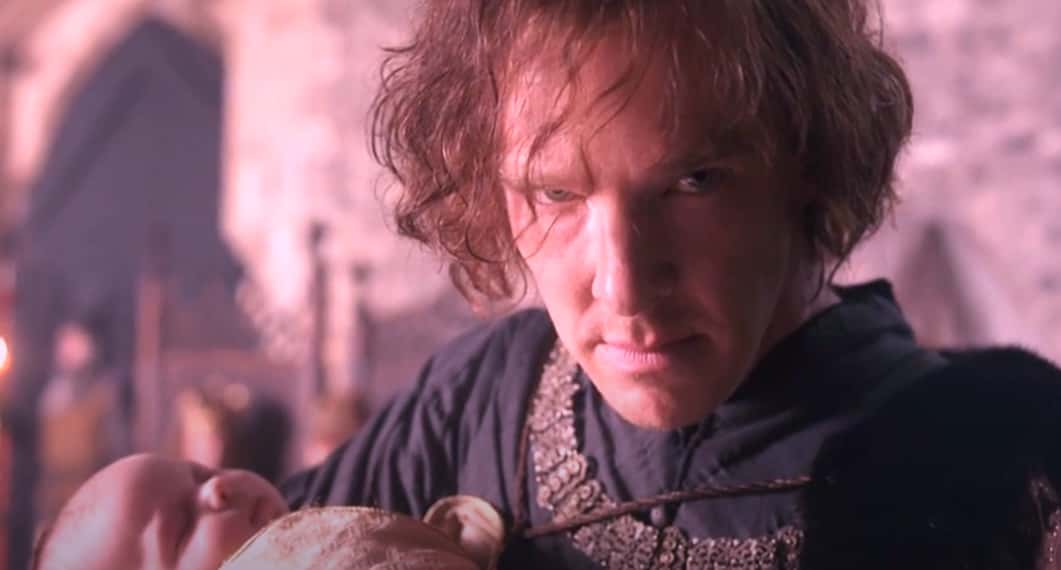 The Hollow Crown (2012– ), BBC
The Hollow Crown (2012– ), BBC
This Changes Everything
Not long after Richard locked his two nephews in the Tower of London, England was rocked by an absolute bombshell. A sermon held outside Old St. Paul's Cathedral proclaimed that Edward IV's marriage had been illegitimate. This meant that his two sons were bastards, and that Richard was the rightful King of England. Whether or not that was totally accurate, one thing is for sure: No one needed to tell Richard twice.
He quickly seized power and was crowned King Richard III. England had seen years of peace—but the Wars of the Roses were about to start up once again.
The Mysterious Princes
Throughout Richard III's reign, rumors swirled that the Princes in the Tower may have escaped, and could one day return to challenge him for the throne. After all, stranger things had happened during the Wars of the Roses. While it's unlikely to be true, there were still several ambitious young men who were ready and willing to throw their hats into the ring. Over the years, multiple men surfaced claiming to be one of the Princes in the Tower.
Each time, a small rebellion sprang up around these men, and each time, whoever was king had to strike them down.
The Hollow Crown
If you're keeping track, this marks the fifth time that the English crown changed hands since the start of the Wars of the Roses. And this time, like all the others, when the new king was crowned under...unique circumstances, there was no shortage of people who challenged him. Almost as soon as the crown touched Richard III's head, a conspiracy formed that sought to take it back off.
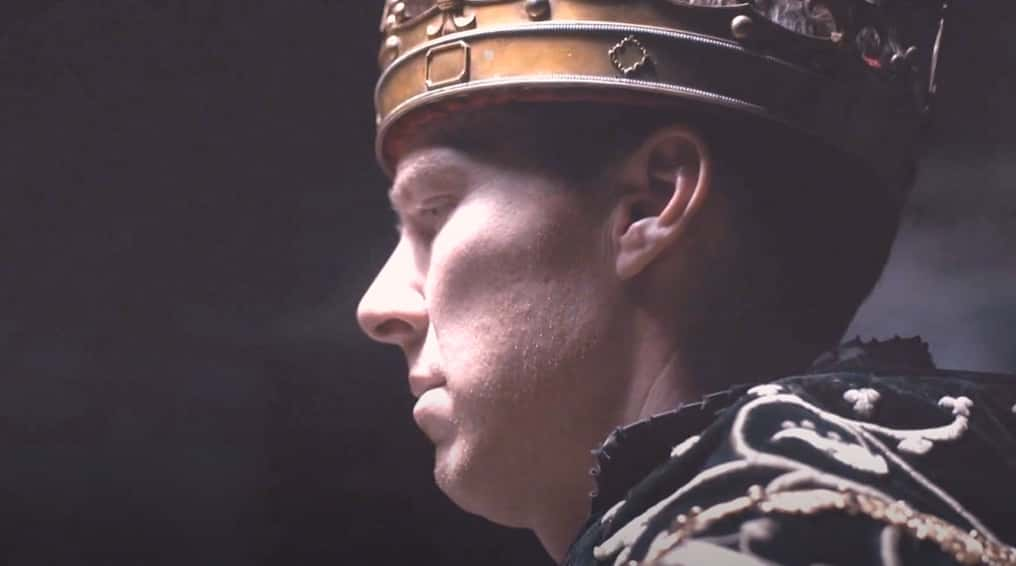 The Hollow Crown (2012– ), BBC
The Hollow Crown (2012– ), BBC
A New Challenger Approaches
Richard's biggest challenger was his first cousin, the Duke of Buckingham. But while Buckingham was the movement's figurehead, the truth was that many nobles across England remained loyal to Edward and were disgusted by what Richard had done. However, the conspirators had a major problem: With the Princes in the Tower nowhere to be found and all traces of Henry VI's bloodline extinct, they didn't actually have anyone to replace Richard with.
But the Duke of Buckingham was nothing if not crafty. He was well aware that there was still a man out there who could potentially end the Wars for good: a man by the name of Henry Tudor.
Rags to Riches
For most of their history, the Tudors were a relatively small Welsh family. They were reasonably well-off, but nowhere near royalty. But Owen Tudor, Henry Tudor's grandfather, changed all that with a secret marriage that shocked the English court. Owen had served Henry V bravely—and in that time, he became close with Henry's wife, Queen Catherine of Valois.
If anyone thought that Owen Tudor was getting a little too close with the Queen, their suspicions would eventually prove correct. Not long after Henry V's death, Tudor secretly married Catherine, and the scandalous couple gave birth to a son.
The Nobody Who Wanted the Crown
Henry Tudor, Owen Tudor's grandson, fought bravely for the Lancastrians during the early years of the Wars of the Roses. When the Yorkists won, he went into exile in France—until one day, the Duke of Buckingham came to him and suggested that he challenge Richard III for the throne. After all, his grandmother had been the Queen, and he could trace his ancestry back to King Edward III.
Henry Tudor had a claim to the throne, if tenuous, but that wasn't all. The Duke of Buckingham had come up with an ingenious plan to make sure that Henry could finally end the Wars of the Roses once and for all.
The Best of Both Worlds
The reason the Wars of the Roses went on for as long as they did was simple: England was too divided for anyone to stay content for long. When there was a Lancaster King, there was a Yorkist who wanted to tear him down, and vice-versa. So, the Duke of Buckingham came up with a solution: On Christmas Day, 1483, Henry Tudor, a Lancaster, pledged to marry Elizbeth of York, Edward IV's own daughter. This move was, simply put, completely genius.
The Lancastrians were angry that a Yorkist was on the throne. The Yorkists were angry that Richard III had essentially stolen the throne from Edward's son. So how about a Lancaster married to one of Edward's children? Everybody wins! There was just one problem...and his name was Richard III.
This is Going to End, One Way or Another
Henry Tudor had seemingly come out of nowhere, but suddenly he seemed like the perfect man to put an end to the Wars of the Roses once and for all. But Richard III had (probably) killed his own nephews in cold blood to claim the throne. He wasn't about to let some young upstart and steal what he'd taken by force. Henry was an unstoppable force, and Richard was an immovable object.
Of course, when they finally clashed, the results were absolutely brutal.
The Storm
The Duke of Buckingham had helped to mastermind the plot against Richard III—but he wouldn't live to see it come to fruition. Before he could join his forces with Henry Tudor's, disaster struck. Vicious storms ravaged through the English Channel at the worst possible time, and Henry's troops couldn't land in England. Meanwhile, Buckingham's own armies were also hampered by the storm, and before they knew it, Richard III had arrived with an army of his own.
 The Hollow Crown (2012– ), BBC
The Hollow Crown (2012– ), BBC
The King has Arrived—And He's Not Happy
Without Tudor's help, the Duke of Buckingham was hopelessly outmatched against the King's army. In a last-ditch effort, Buckingham tried to disguise himself and sneak away under cover of darkness. However, no disguise could save him from his dark fate. The king's forces apprehended Buckingham, and he was immediately brought to Salisbury, convicted of treason, and beheaded.
There Were No Good Guys in The Wars of the Roses
If you're feeling bad for the Duke of Buckingham right about now, let me put your conscious at ease. Remember the poor Princes in the Tower? Well, many sources believe that it was actually the Duke of Buckingham himself who killed them.
Invasion
Henry Tudor lost a major ally in the Duke of Buckingham—but it didn't stop him. Tudor called off his invasion of England and fled to Paris—but within about a year, he'd already amassed a large enough force to try it again. This time, there was no storm to stop him. From the second Henry Tudor stepped foot on English soil in 1485, Richard III's days were numbered.
Never Tell Me the Odds
Despite the fact that so many in England were unhappy with Richard III's rule, there actually weren't that many who were willing to outright defy him. After all, Richard was intelligent, battle-hardened, and ruthless. He was not a man to be crossed lightly. So, when Richard and Henry Tudor finally met at the Battle of Bosworth Field, Tudor found himself completely outnumbered.
It seemed as though the battle was going to be a formality—a small footnote in Richard III's long and successful reign. But fate had different ideas that day...
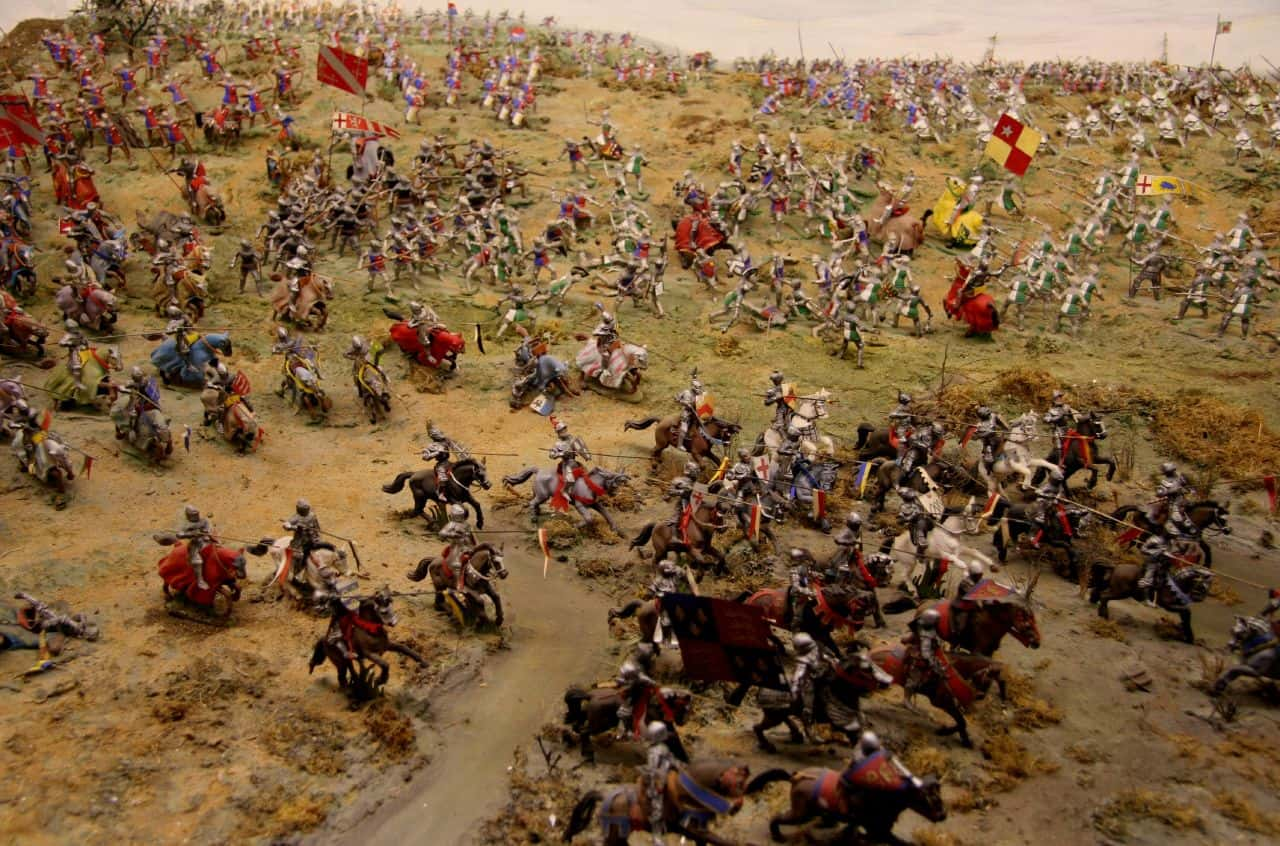 Wikimedia Commons, John Taylor
Wikimedia Commons, John Taylor
A Game of Chess
Richard had spent half of his life on the battlefield, so he took command of his own forces at Bosworth Field. Henry Tudor, however, had next to no experience with warfare. This should have been a major disadvantage, but Tudor was smart enough to realize that he was outmatched. He offered up complete control of his forces to the battle-hardened Earl of Oxford—and it turned out to be the right decision.
 The Hollow Crown (2012– ), BBC
The Hollow Crown (2012– ), BBC
Divide and Conquer
Richard split his army into three groups. He put the Earl of Northumberland in charge of one, the Duke of Norfolk in charge of another, and personally led the third group. This was quite standard for medieval battles—but it would prove to be a crucial mistake. In the chaos of the battle, Richard and Norfolk's forces engaged the enemy, while Northumberland was told to keep his men in reserve.
By the time Richard realized he'd been betrayed, it would be too late...
Richard Was on His Own—But He Had a Backup Plan
As the battle raged, Richard decided it was time to bring his full force against Henry Tudor, ending the engagement once and for all. He signaled for the Earl of Northumberland to bring his men into the fray...but Northumberland stayed right where he was. Suddenly, Richard's advantage had gone up in smoke. It was anyone's game, but just as Richard's luck had seemed to run out, he gazed across the battlefield—and couldn't believe what he saw.
 The Hollow Crown (2012– ), BBC
The Hollow Crown (2012– ), BBC
Richard v. Henry
Through the brutal fighting, Richard saw his nemesis, Henry Tudor, sitting vulnerable just behind his forces. With no sign of help from Northumberland, Richard came up with a new plan to put an end to the battle before it got even more out of hand. He gathered his best men around him and charged through the madness, straight at Henry Tudor.
One way or another, the Battle of Bosworth Field—and with it, the Wars of the Roses—were about to come to an end.
 The Hollow Crown (2012– ), BBC
The Hollow Crown (2012– ), BBC
Richard Was a Brutal Warrior—But Henry Wasn't Helpless
Henry Tudor and his personal bodyguard only noticed Richard charging towards them when the king was almost on top of them. Richard's men slammed into Tudor's like a freight train. The king personally killed Henry's standard-bearer in the initial charge. He also unhorsed John Cheyne, a mountain of a man who had served under Edward IV and whom Richard certainly knew very well.
But while Richard cut down Tudor's men, Henry himself was nowhere to be seen. It seemed like he had completely disappeared—Henry Tudor was inexperienced in battle, sure, but he still had a few tricks up his sleeve.
Hiding in Plain Sight
Just before Richard had appeared, Henry had gotten off his horse and disguised himself among his retinue of bodyguards and mercenaries. After all, Richard would have been looking for him on a horse, not down in the mud. This plot probably only bought him a few precious seconds—but that was all it took.
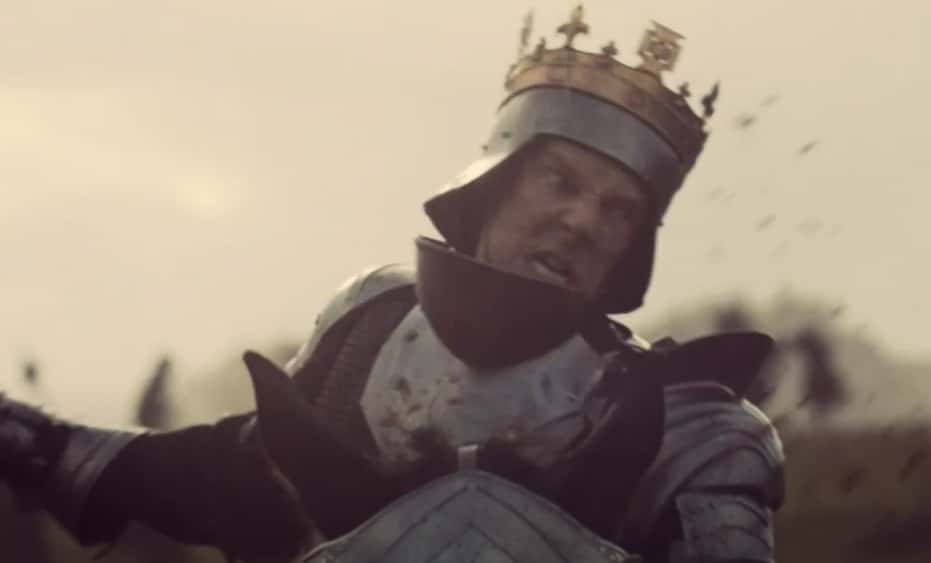 The Hollow Crown (2012– ), BBC
The Hollow Crown (2012– ), BBC
Richard Was Running Out of Time
Richard went on an absolute rampage, felling men left and right in his search for Henry Tudor. According to accounts of the battle, he managed to fight himself to within just a few sword's lengths of Henry—but eventually, Henry's forces began to take the upper hand. They surrounded the king and managed to push him back a few hundred yards towards the edge of a marsh.
Richard fought bravely, but he was running out of time—and that's when disaster struck.
 The Hollow Crown (2012– ), BBC
The Hollow Crown (2012– ), BBC
To Die as a King
Richard's horse suddenly lost its footing in the marshy ground and toppled over, bringing the king down with it. Unhorsed, and with precious few men still with him, Richard still refused to back down. Allegedly, he stood up, raised his sword, and cried, "God forbid that I retreat one step. I will either win the battle as a king, or die as one." He stayed true to his word—but I doubt he hoped for the latter option.
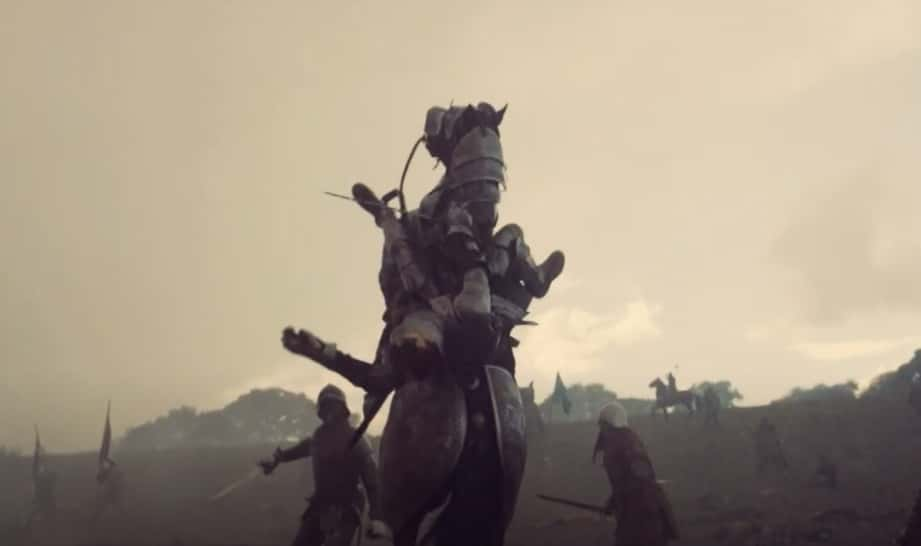 The Hollow Crown (2012– ), BBC
The Hollow Crown (2012– ), BBC
The Banner Yet Waves
The men who followed Richard into battle stayed with him until the bitter end. Richard's own bannerman, Sir Percival Thirlwall, lost his legs in the fighting, but even then he didn't surrender. Unable to stand, Thirlwall still ensured that the Yorkist banner flew over Bosworth Field until one of Tudor's men finally finished him off.
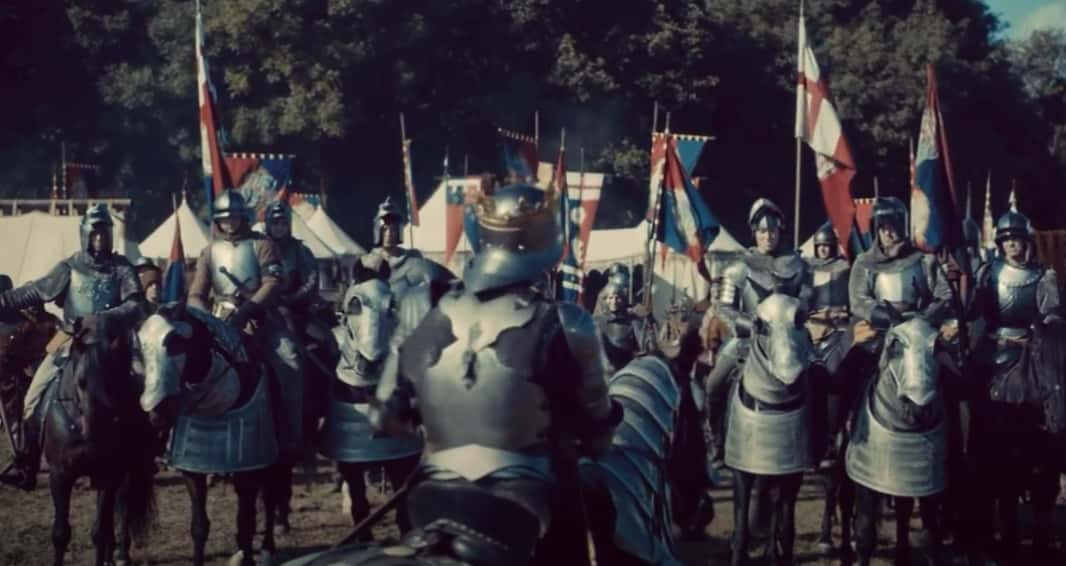 The Hollow Crown (2012– ), BBC
The Hollow Crown (2012– ), BBC
Blood Will be Thy End
Richard III, the forgotten son of the legendary Richard, Duke of York, managed to beat all the odds and take the English throne all by himself. It's fitting, then, that he died alone, surrounded by his enemies, fighting until his very last breath. Finally, a fatal blow from a halberd did him in for good. According to accounts of the battle, that last strike was so violent that it drove Richard's helmet into his skull.
Richard III, the last Yorkist king, was dead.
 The Hollow Crown (2012– ), BBC
The Hollow Crown (2012– ), BBC
The Last Word on York Lips
Allegedly, Richard spoke a single word in his final moments: “Treason!” He shouted this as he was fighting to the death, and most historians assume he was referring to the Earl of Northumberland, who had abandoned him to his fate. Fitting, then, that the Wars of the Roses would end in betrayal.
 The Hollow Crown (2012– ), BBC
The Hollow Crown (2012– ), BBC
A Violent End For a Violent Man
After Tudor's forces cut Richard down, they set about desecrating his body. They stripped the king's clothes and either threw it over a horse's back or dragged it behind one. But once the royal remains made it to Henry Tudor, it was a different story. Henry had Richard buried with the usual ceremony of an English King. He even paid the equivalent of around £38,000 for a marble monument to his fallen rival.
However, the location of Richard's grave was then lost, and so it remained for the next 400 years.
 The Hollow Crown (2012– ), BBC
The Hollow Crown (2012– ), BBC
What are the Odds?
In 2012, an expedition to find Richard’s remains led to the former grounds of Greyfriars Church. Part of these grounds were now part of a parking lot. In a bit of superb coincidence, Richard’s body was found under a reserved parking space marked “R.” A study of the remains revealed just how violent his final moments had been.
A Grim Picture of Death
Richard suffered “four minor injuries on the top of the skull, one dagger blow on the cheekbone, one cut on the lower jaw, two fatal injuries on the base of the skull, one cut on a rib bone, and one final wound on [his] pelvis, most probably inflicted after death.” And that’s only the wounds to his bones...
Lancaster and York Were Dead—Tudor Rose From the Ashes
Henry Tudor, who just a few years earlier had seemed miles away from the throne, was crowned King Henry VII of England right there at Bosworth Field. Not long after, he would make good on his promise and marry Elizabeth of York, the daughter of Edward IV and sister to the lost Princes in the Tower. Finally, both the houses of Lancaster and York were together on the throne—but this was no longer their story.
They had been supplanted by Henry Tudor, and it was the Tudors who would reign supreme over England for the better part of the next century.
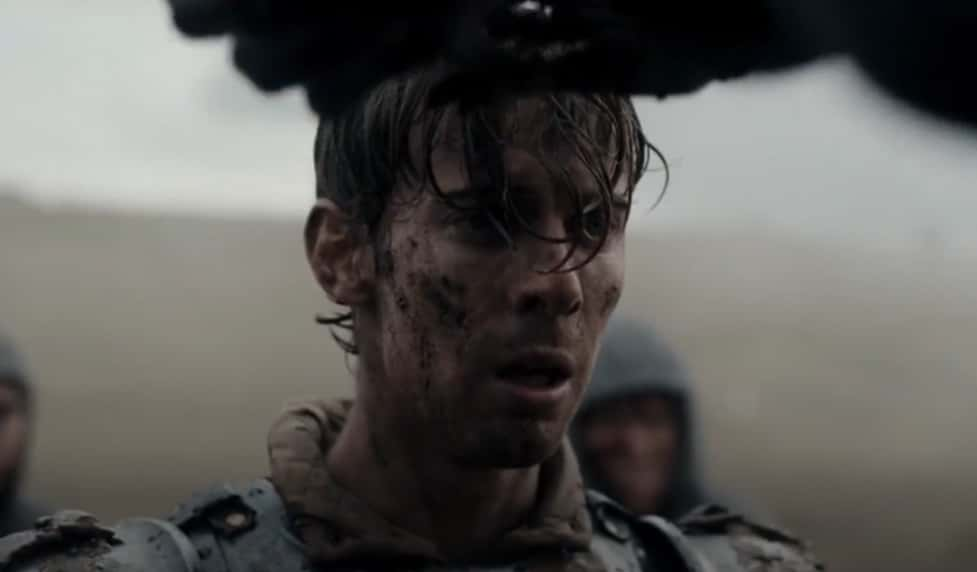 The Hollow Crown (2012– ), BBC
The Hollow Crown (2012– ), BBC
Consolidating Power
Upon becoming king, Henry retroactively dated his reign to start from August 21, 1485—one full day before the death of Richard III. In effect, Henry made everybody who fought with Richard against him at the Battle of Bosworth an official traitor. That also meant the property and titles of anyone who fought against him were forfeit.
But since doing so would effectively uproot most of the English nobility, Henry did allow anyone who swore fealty to him to be spared in life and livelihood. Talk about a power move.
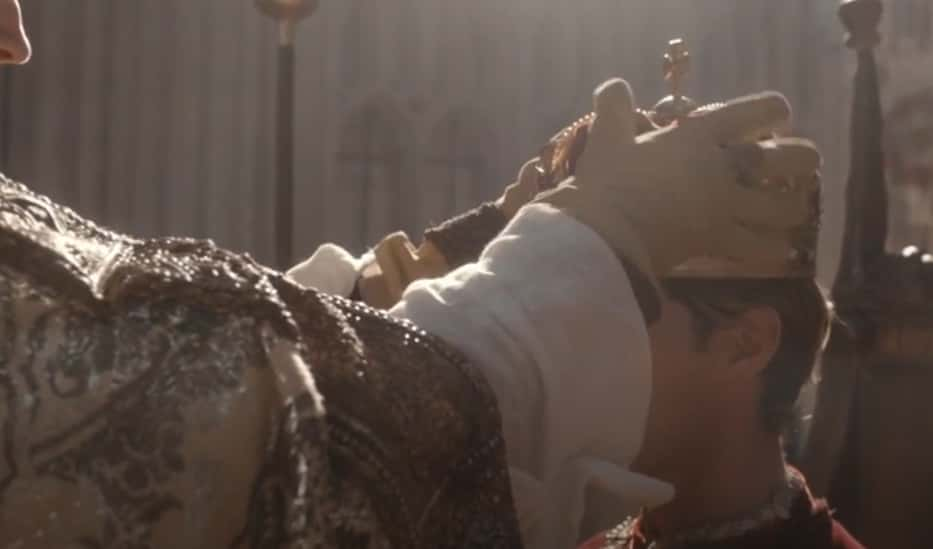 The Hollow Crown (2012– ), BBC
The Hollow Crown (2012– ), BBC
Death Row
Henry VII didn't hold onto his throne by playing nice. Shortly after his ascension, Henry imprisoned Edward, the Earl of Warwick, Richard III's heir. However, he waited 14 years to finally execute the boy.
The Roses Finally Die
After decades of conflict, the Wars of the Roses had finally come to a close. Yes, there were still some small rebellions here and there, but unlike every other king in this article, Henry VII managed to snuff them out and keep hold of his crown. Fittingly, this brutal conflict between York and Lancaster ended with both families technically on the throne.
But the question remains: did both sides win, or did they both lose?
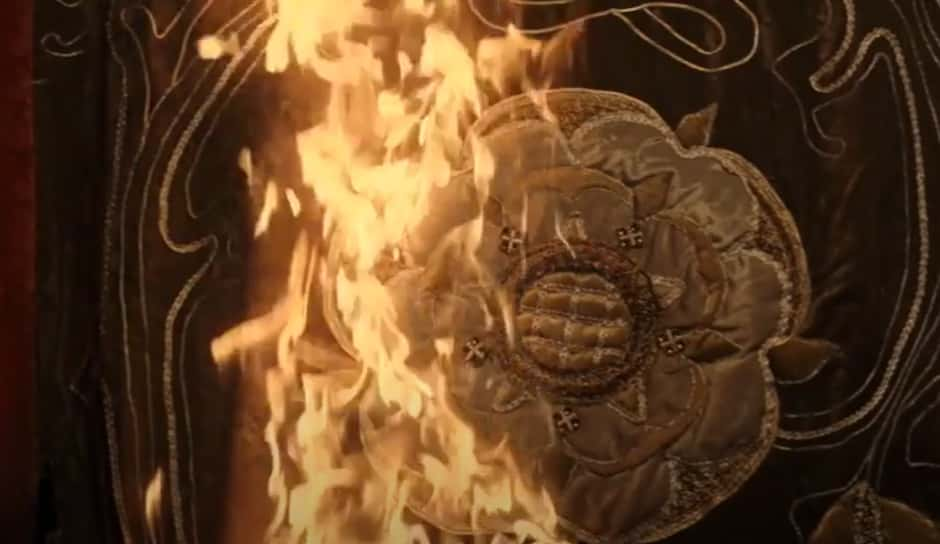 The Hollow Crown (2012– ), BBC
The Hollow Crown (2012– ), BBC
Talk About a Psychopath!
Two knights had kept watch over Henry VI while he was in captivity the first time. When Henry was freed following the Battle of Wakefield, the king promised to spare their lives. But while Henry was merciful, his wife was not—and she had an utterly disturbing revenge in mind. Margaret overruled Henry and asked her son, a child, to decide how the two knights would die. Plot twist: these knights were also his cousins.
When young Edward chose decapitation—all while his relatives begged for their lives—Margaret went ahead with the executions.
There's Something Suspicious Here...
By the time Edward of Westminster died in battle, who knows if his father, Henry VI, even had the mental capacity left to mourn him. Regardless, the Mad King would join his son soon after. Official accounts say that the king died of "melancholy" in the Tower of London, but it's very likely that he met a much darker fate.
Not So Melancholy
Centuries after his death, archaeologists dug up Henry IV’s remains. His light hair was covered in blood and he had damage to his skull. This strongly suggests his death was perhaps less “melancholic” and more “murder-y.”
The Prisoner Princes
Remember those poor Princes in the Tower? Whether or not Edward IV's marriage was actually legitimate or not, as soon as Richard III was crowned, his nephews' fates were sealed. From that point on, their presence served as a disturbing reminder of their uncle's ruthlessness. They were never seen again after Richard III's coronation.
Everyone in England assumed that Richard had his two nephews killed, but no one ever knew for sure. But centuries later, workmen in the Tower made a chilling discovery.
Two Small Skeletons
During renovations to the Tower of London in 1674, workers uncovered an eerily small wooden box. Inside, they discovered the skeletons of two children. Though it's impossible to prove, it's widely believed that those bones belonged to the two tragic Princes in the Tower. While their specters hung over England for years after their imprisonment, most historians believe their deaths likely happened soon after they first disappeared.
Sources: 1, 2, 3, 4, 5, 6, 7, 8, 9, 10, 11, 12, 13, 14, 15, 16, 17, 18, 19, 20, 21, 22, 23, 24, 25

